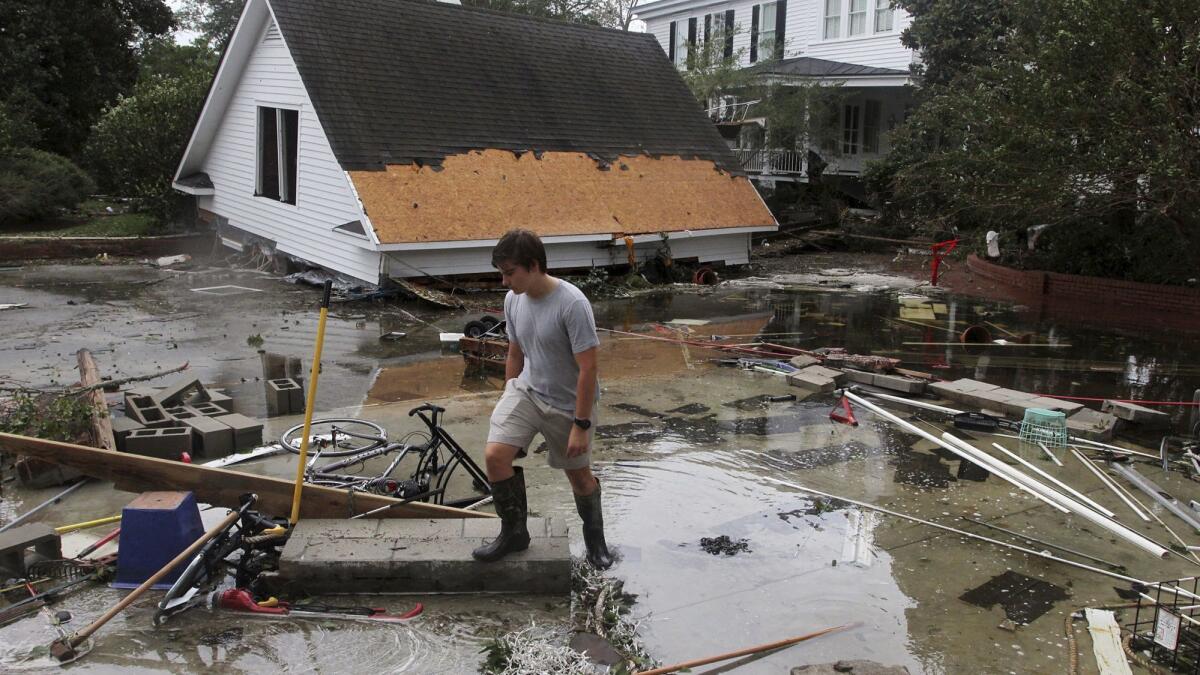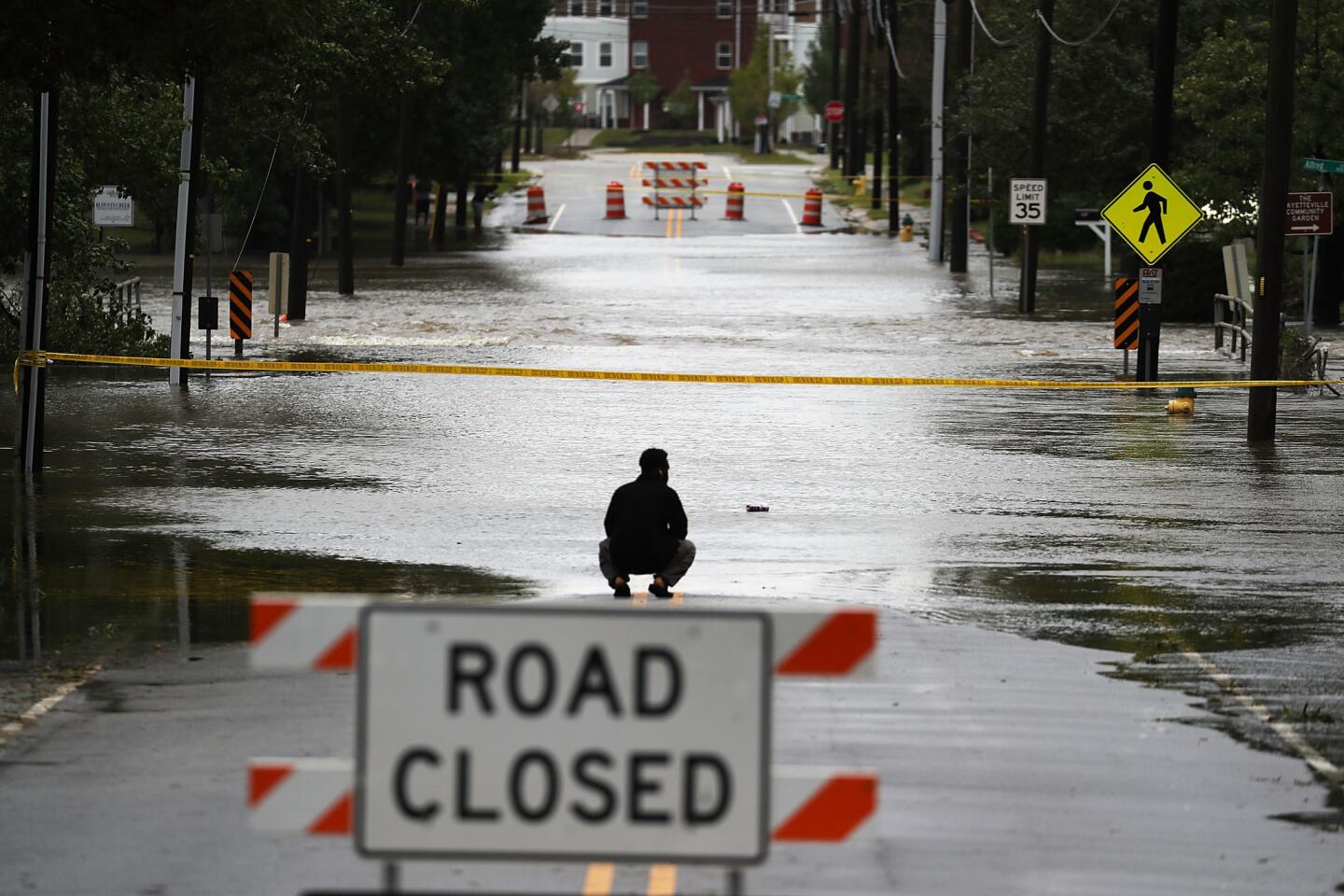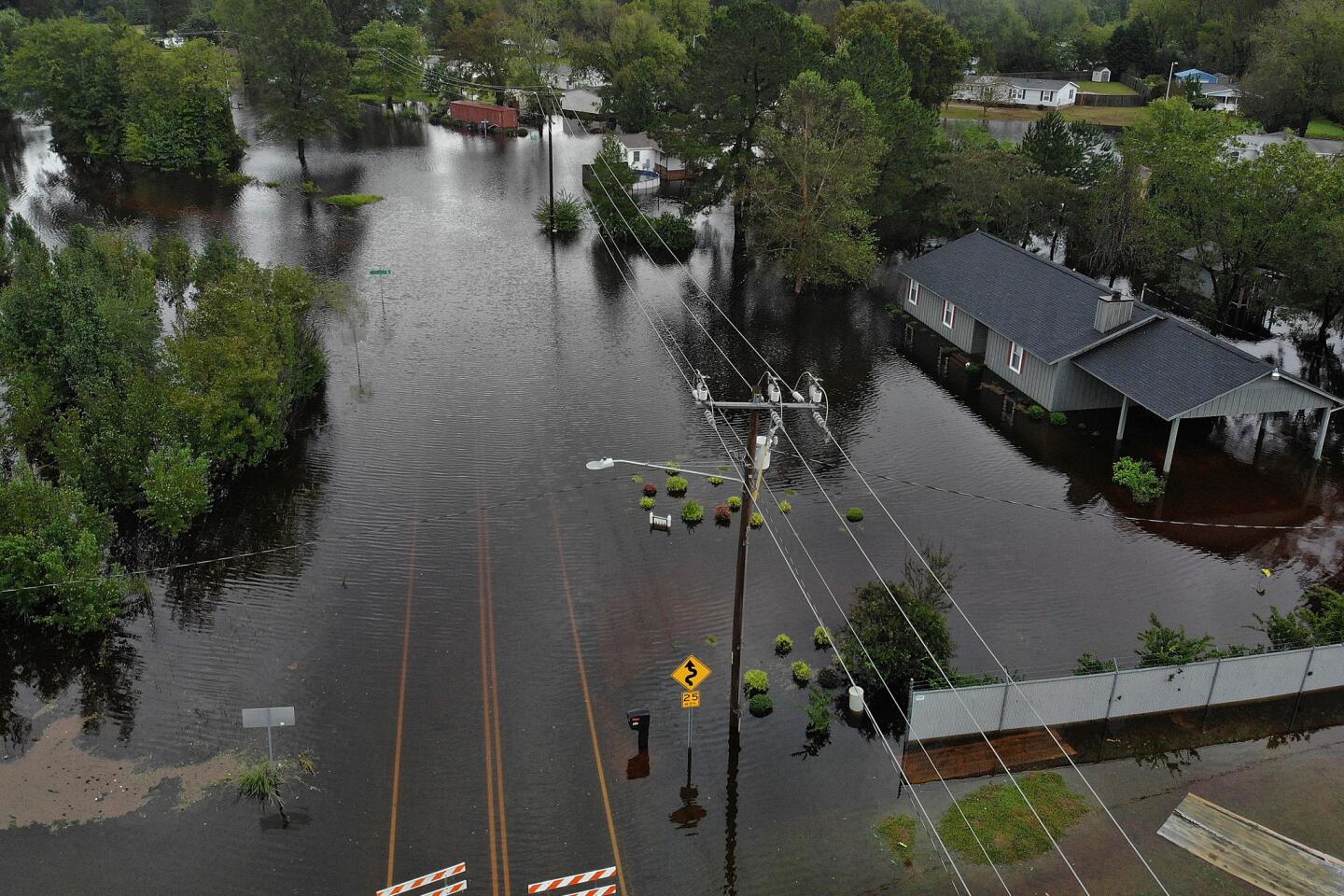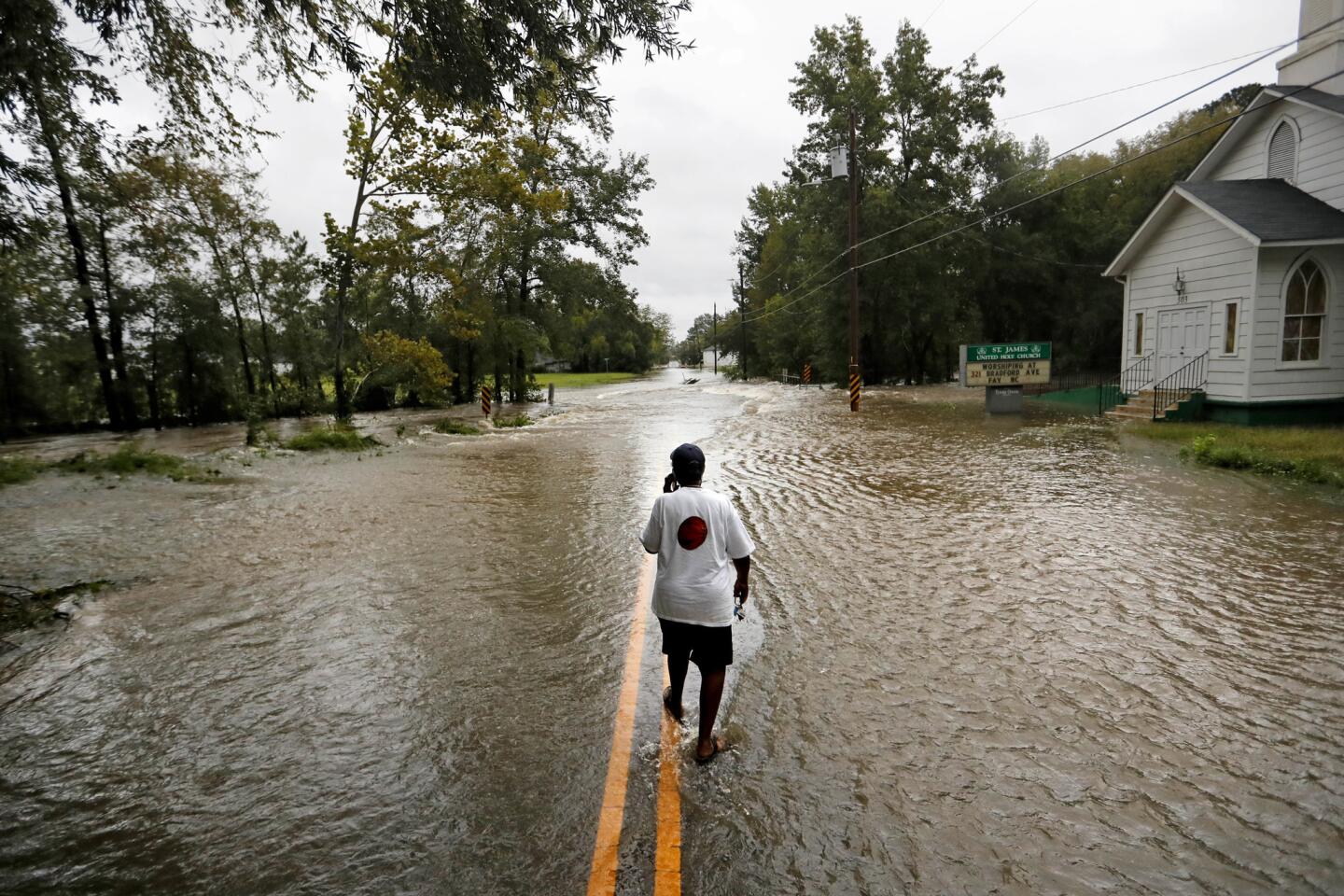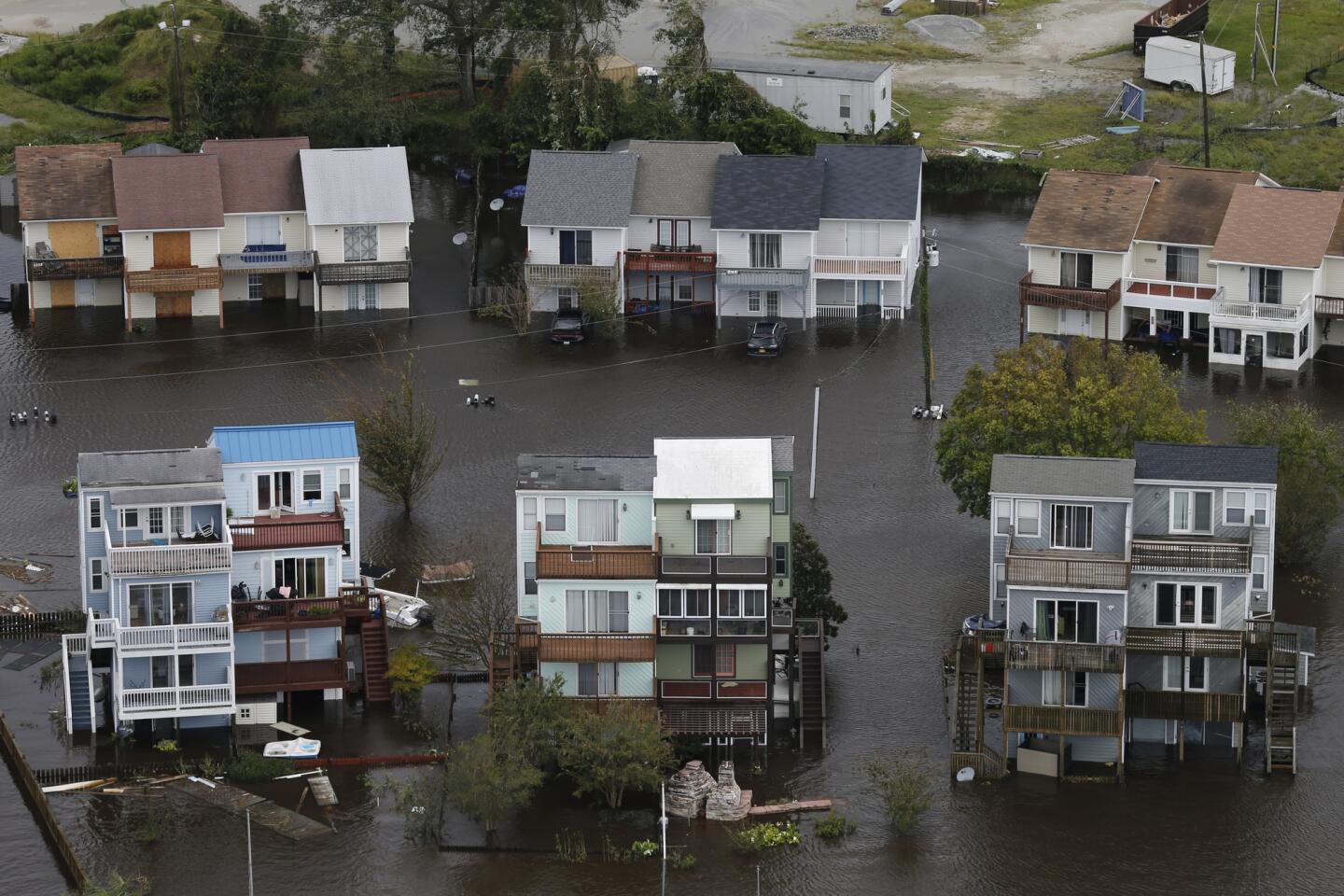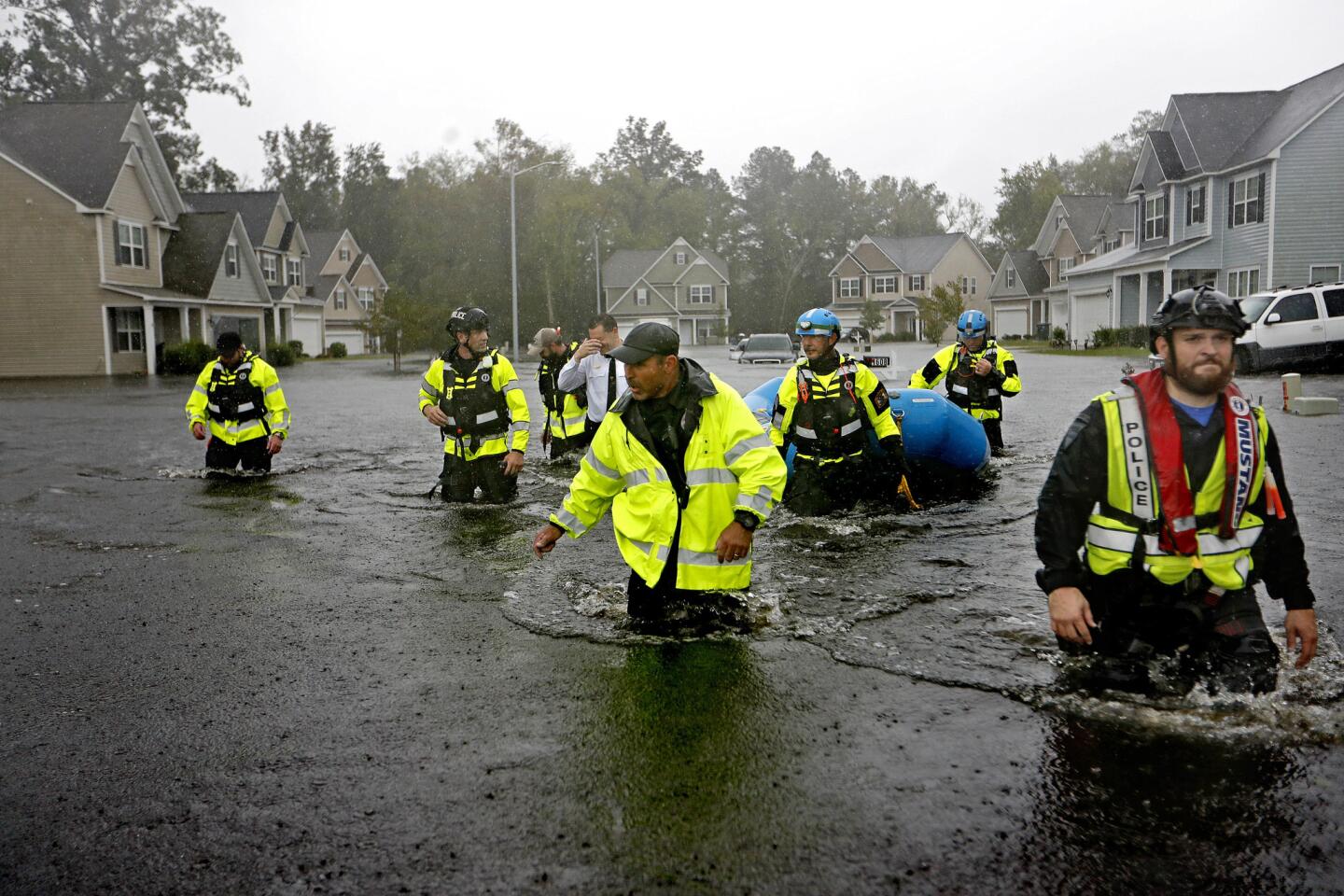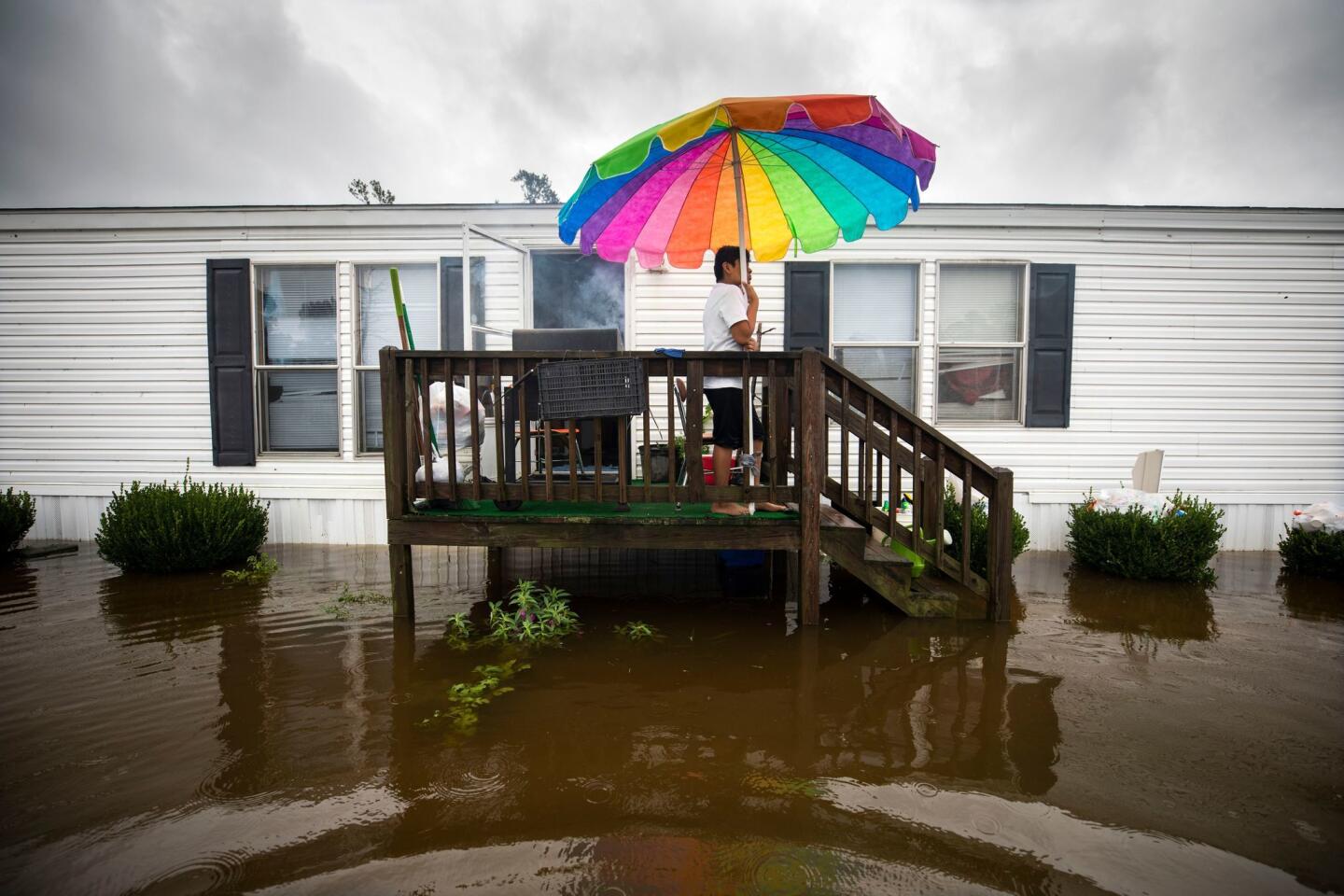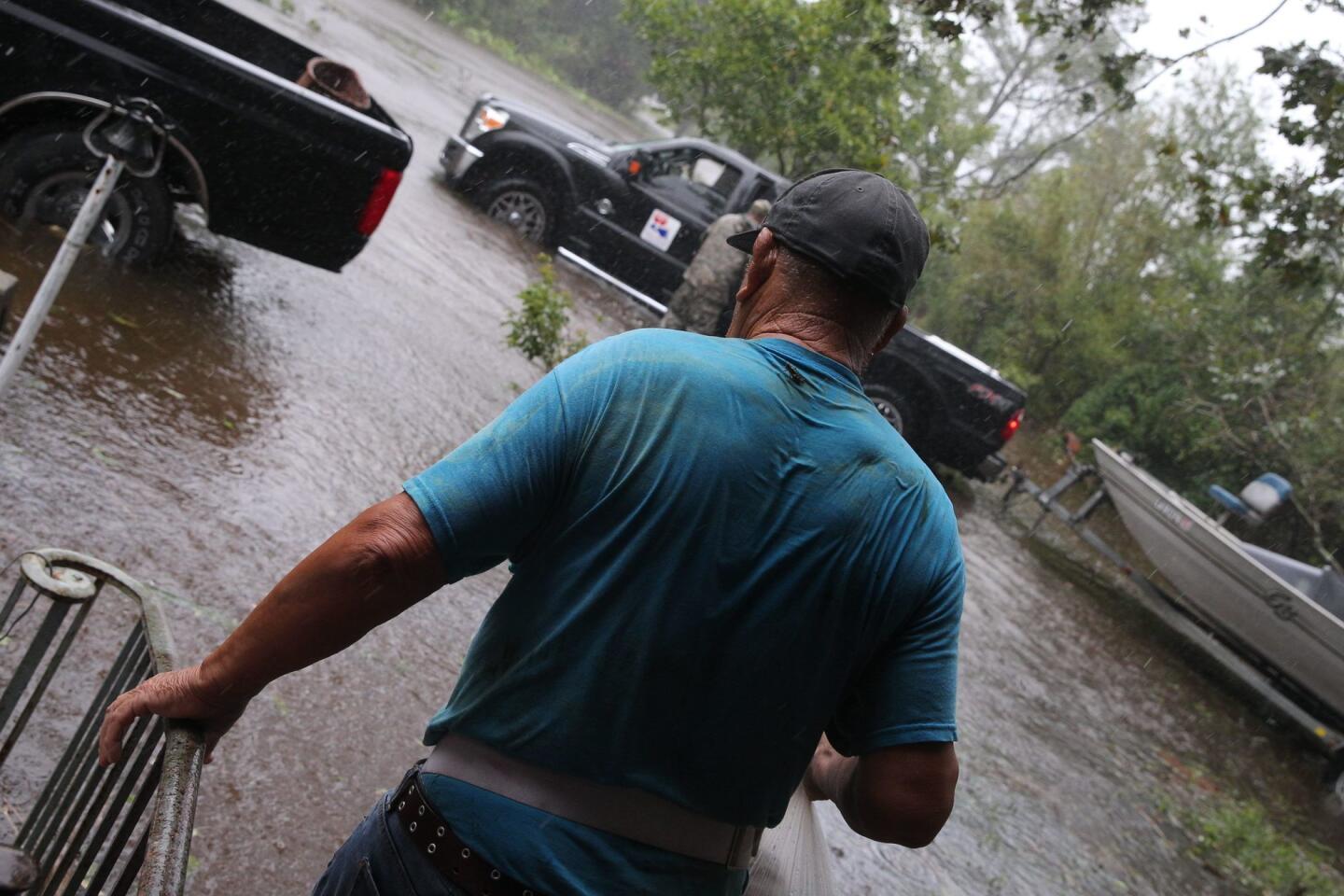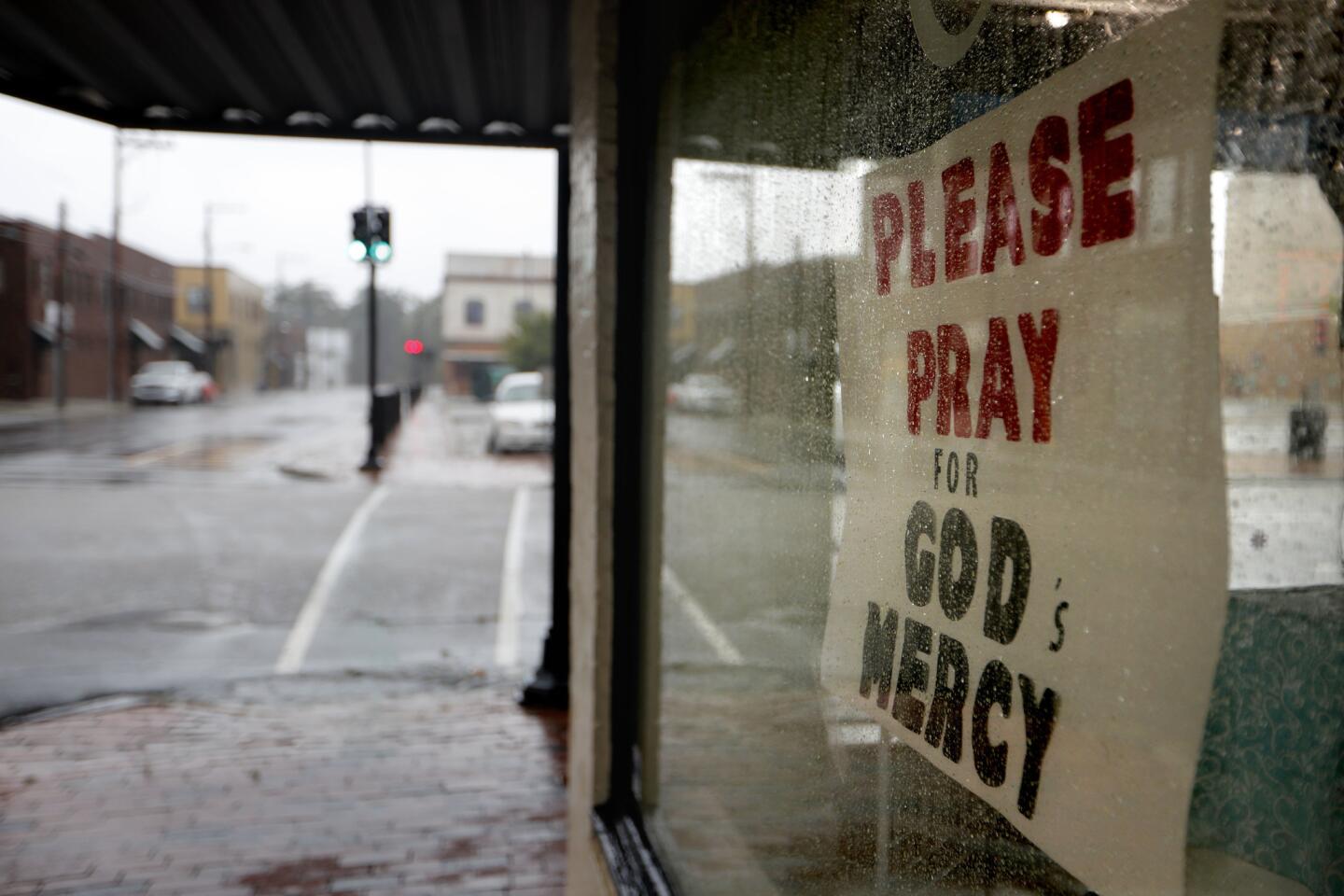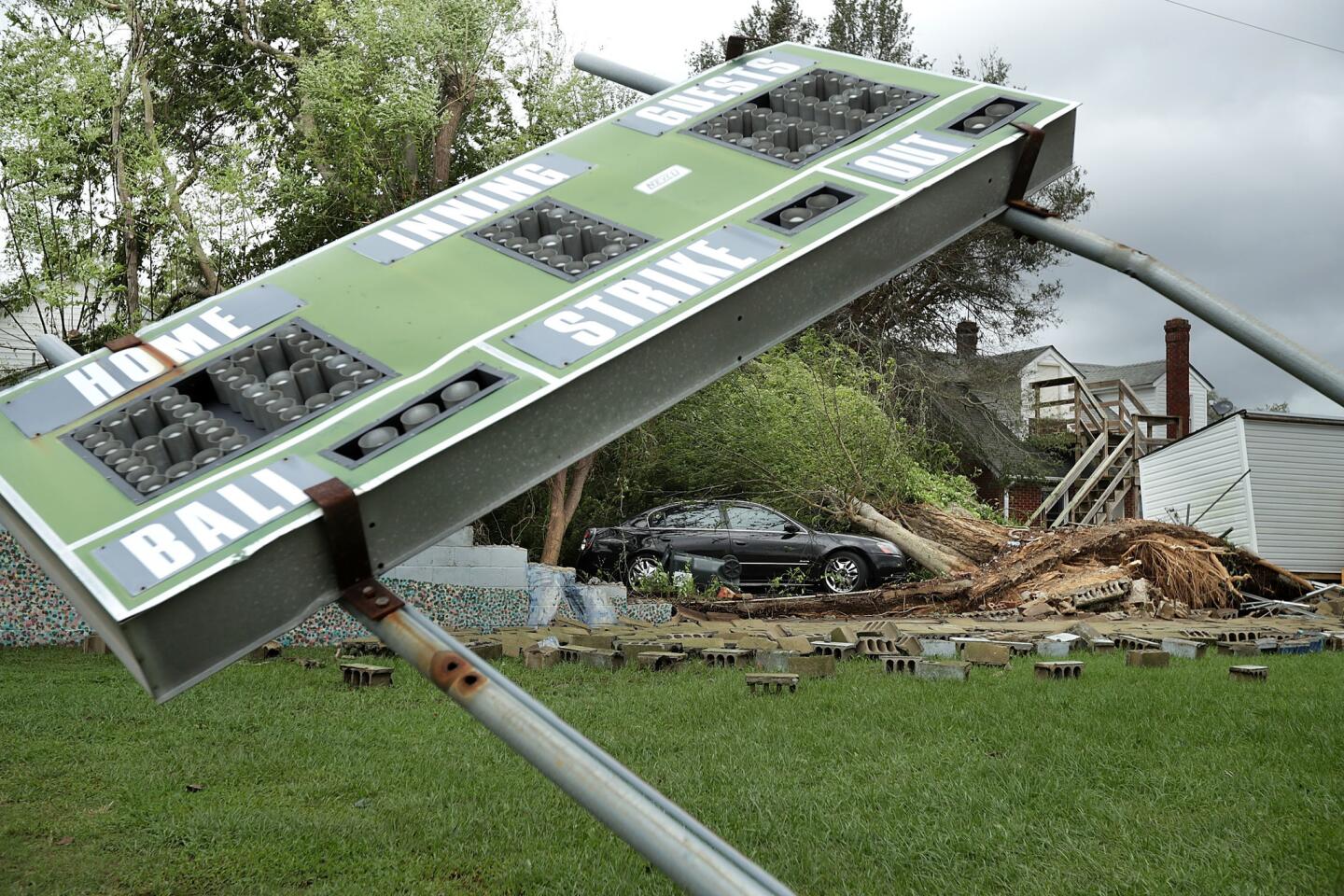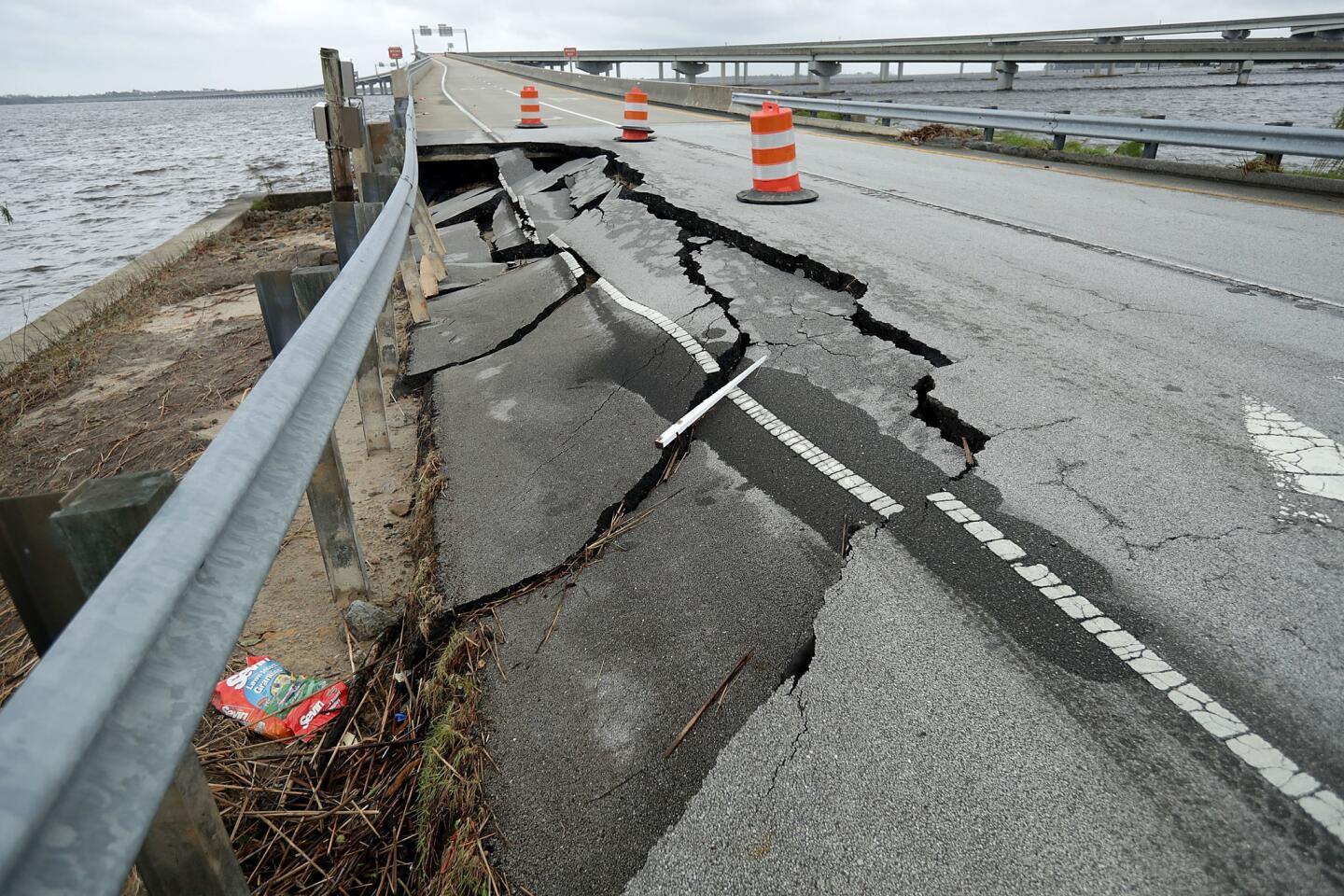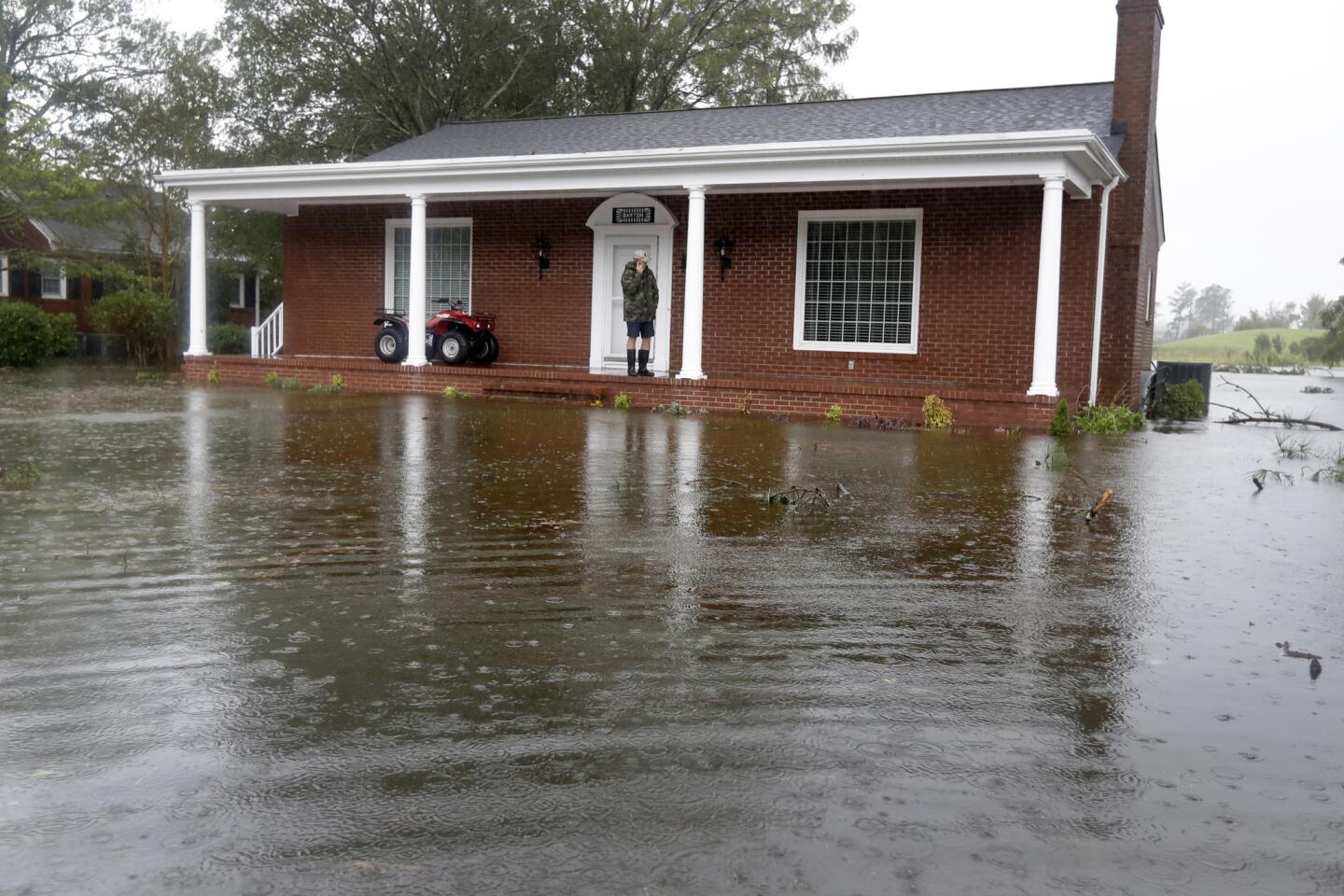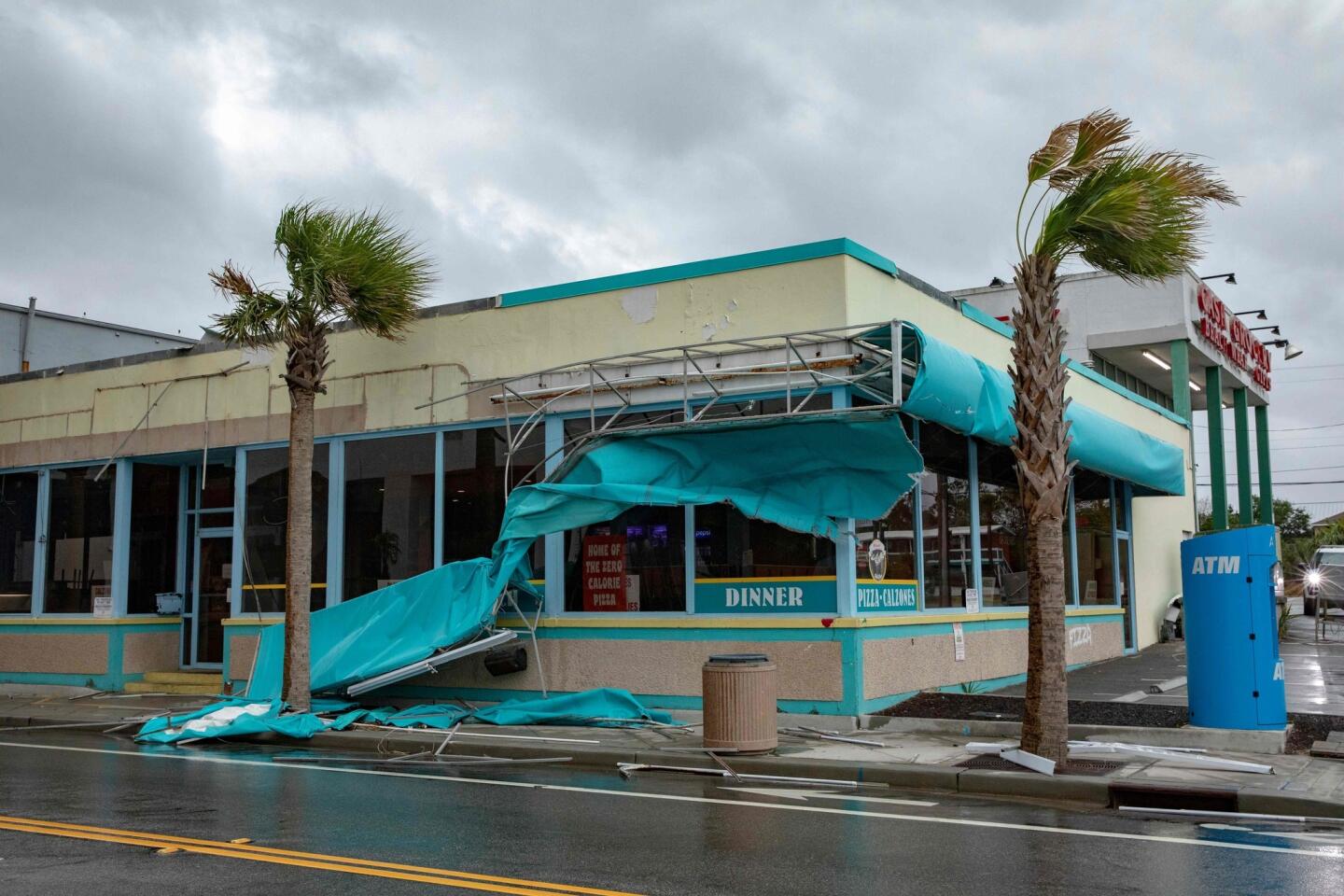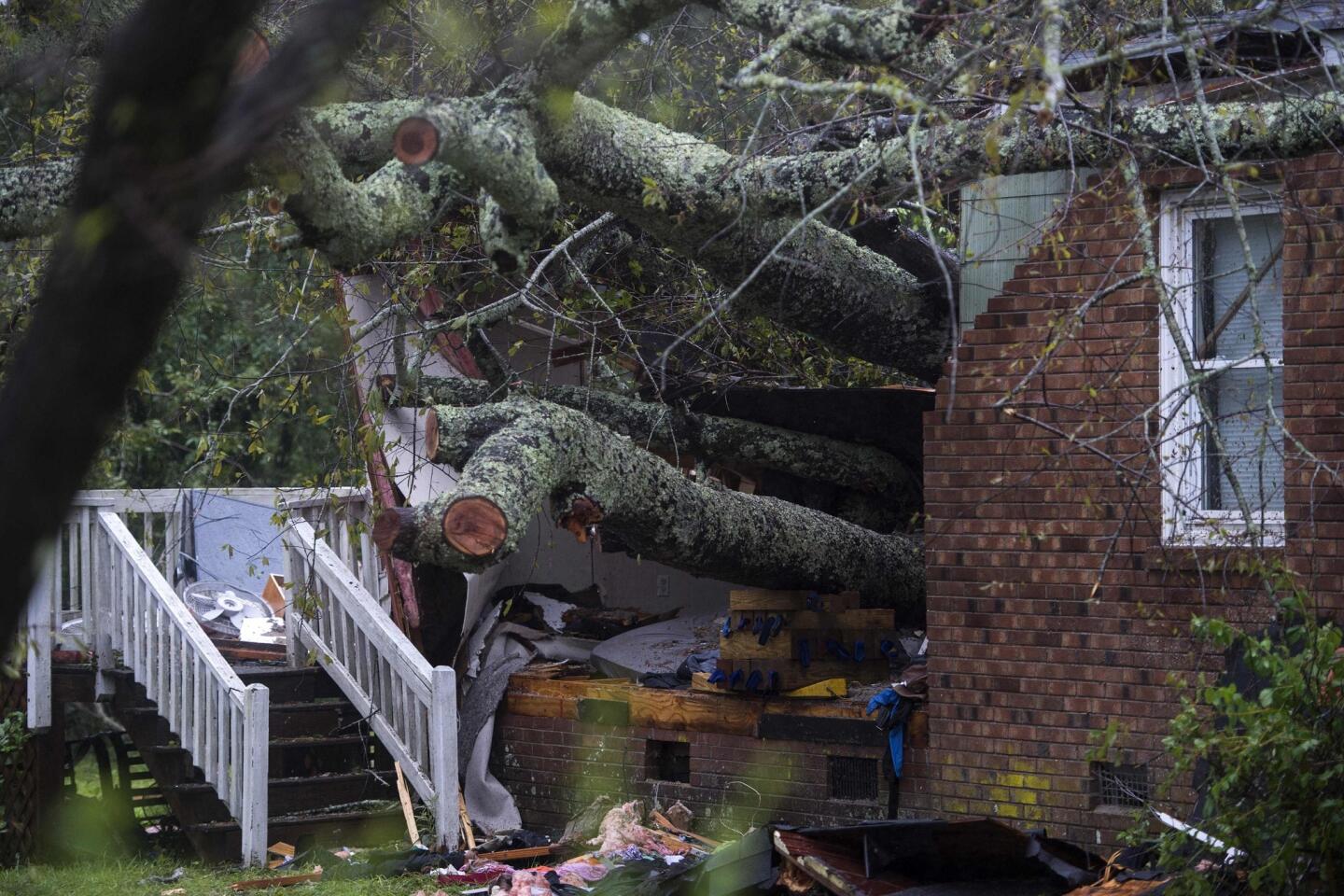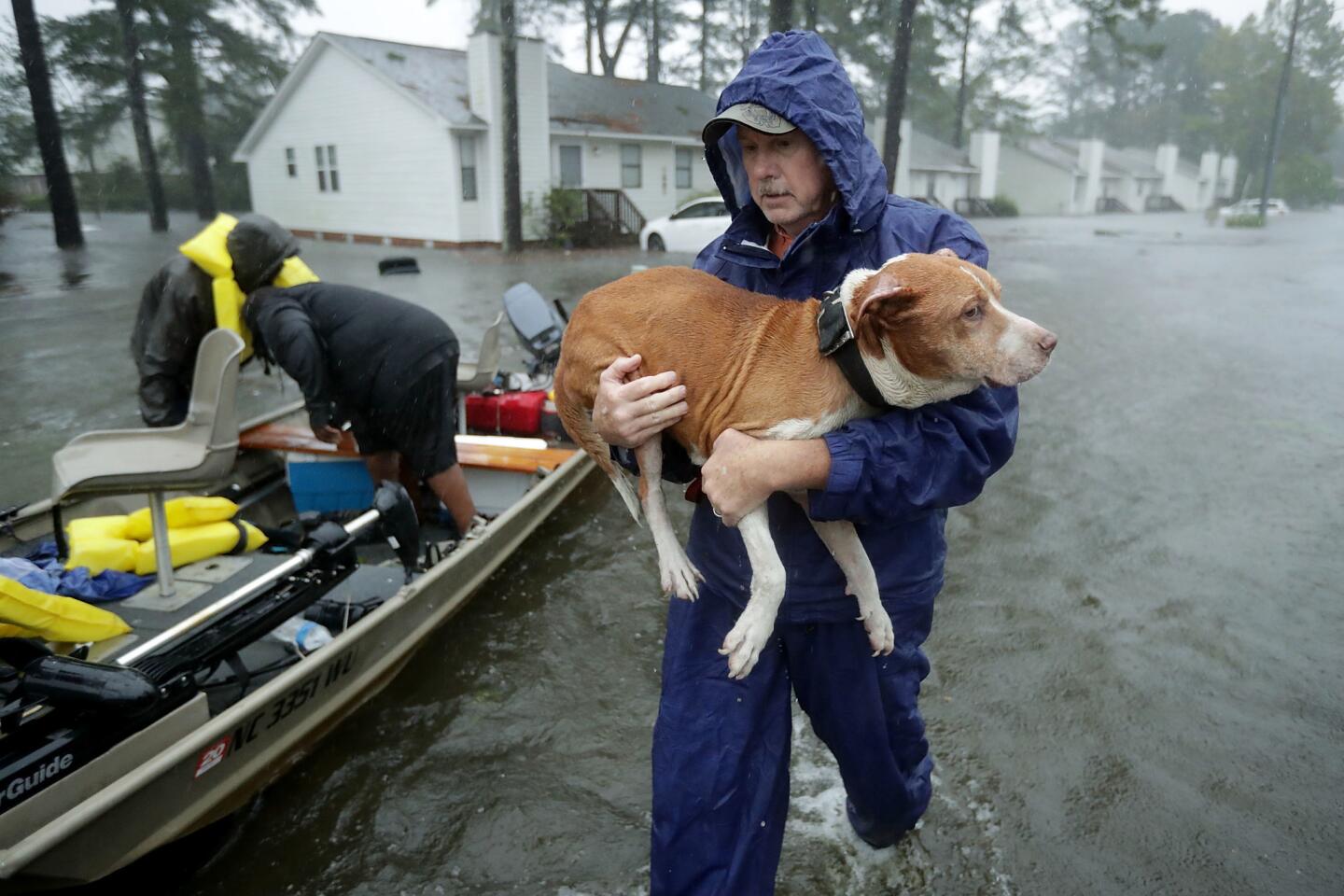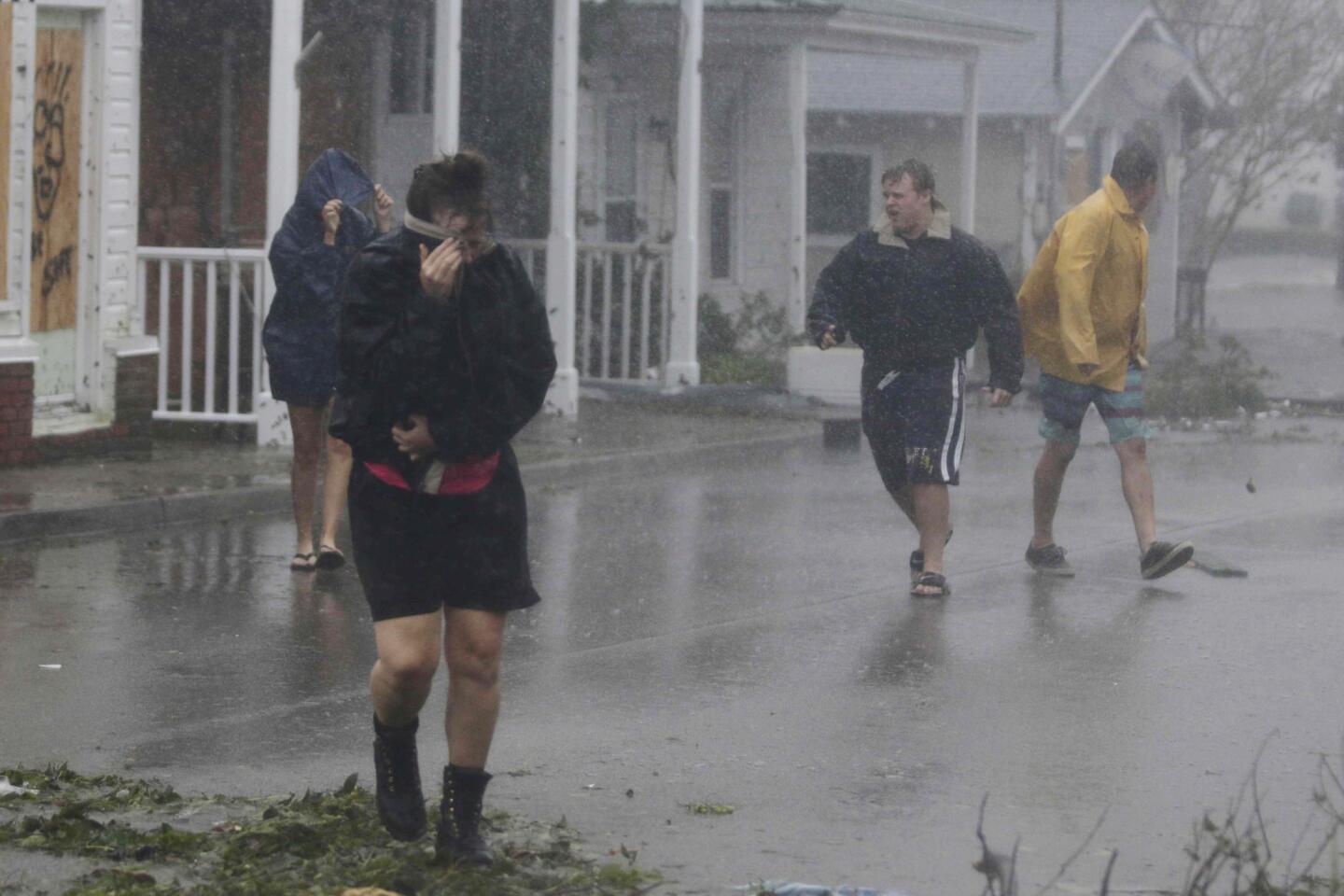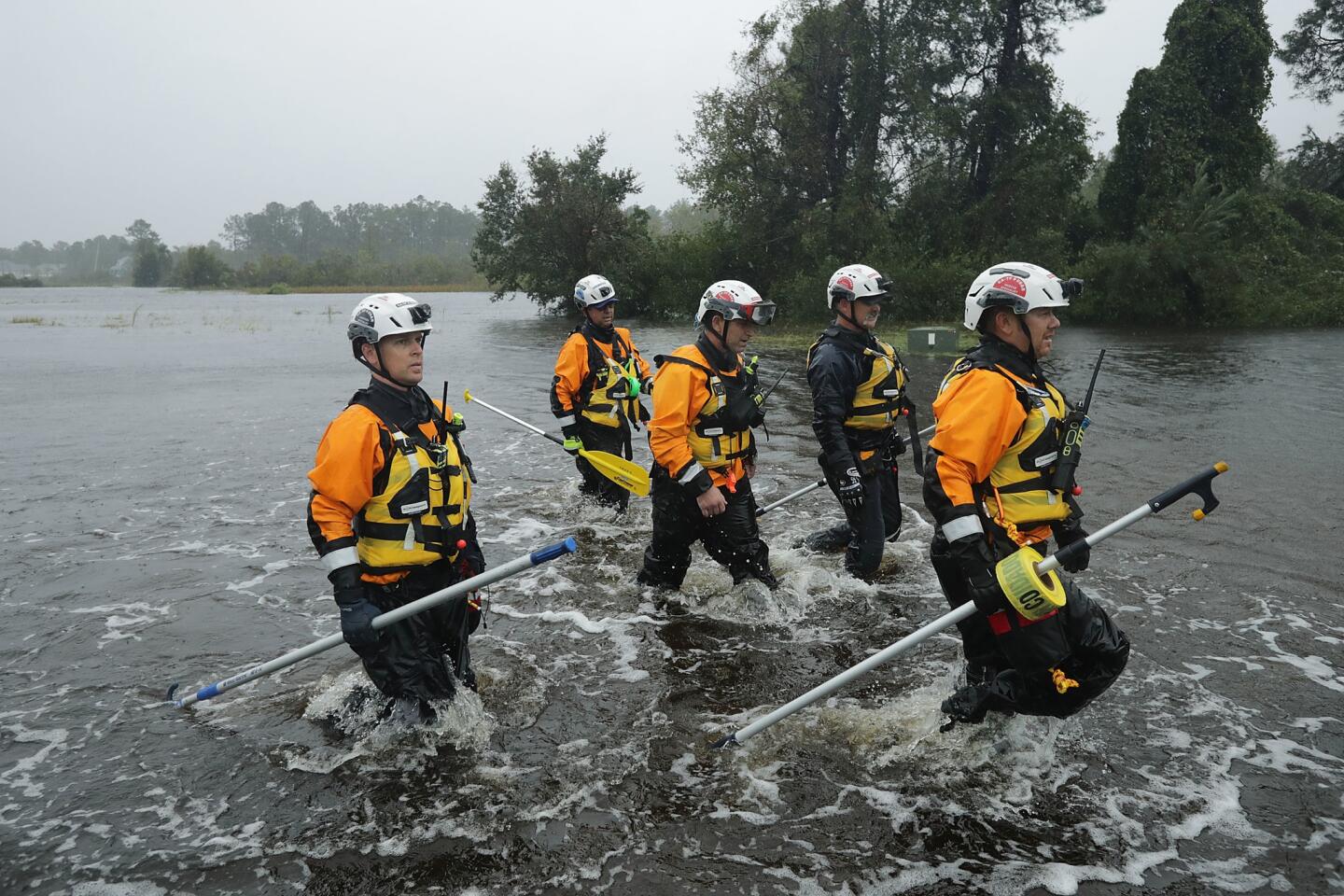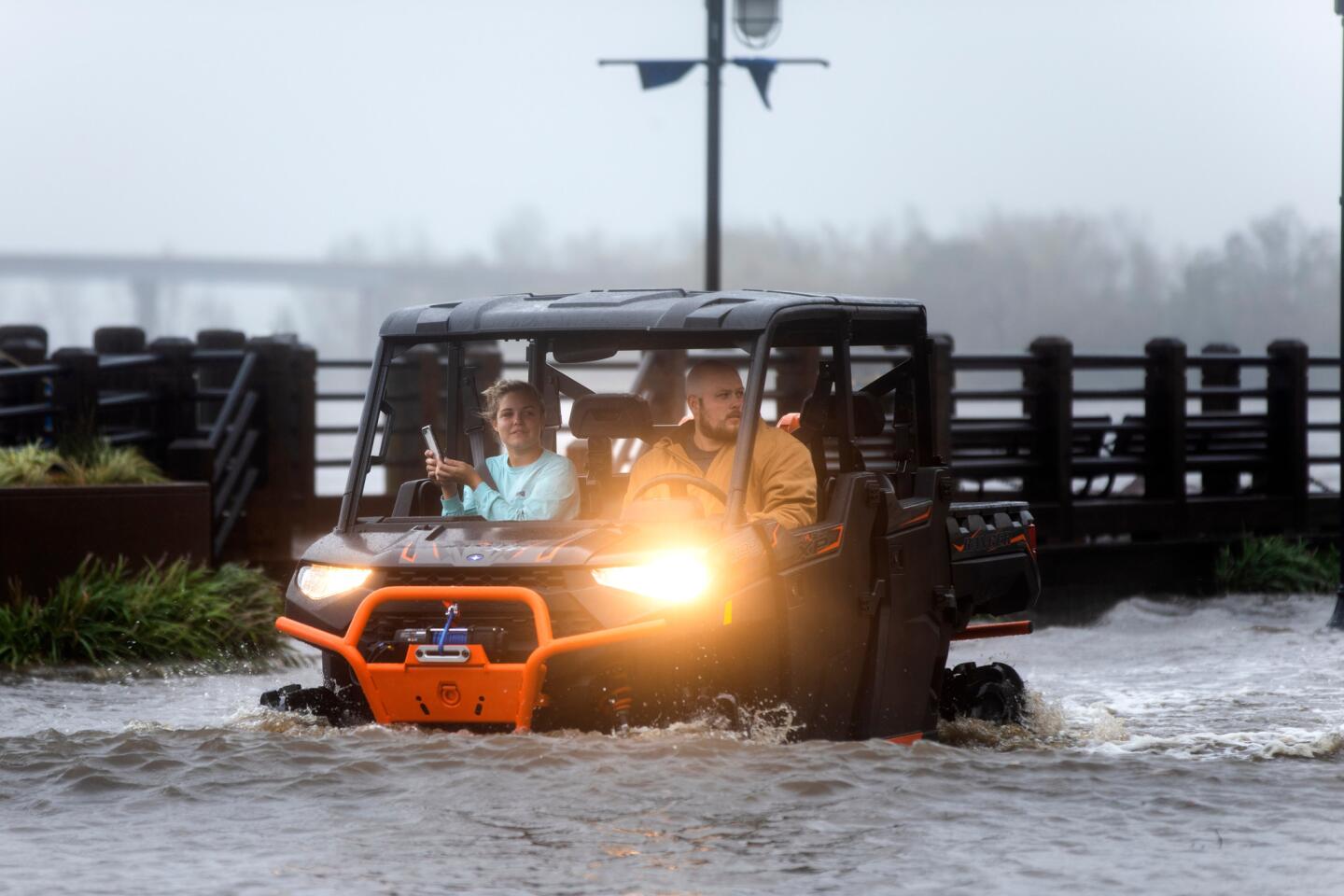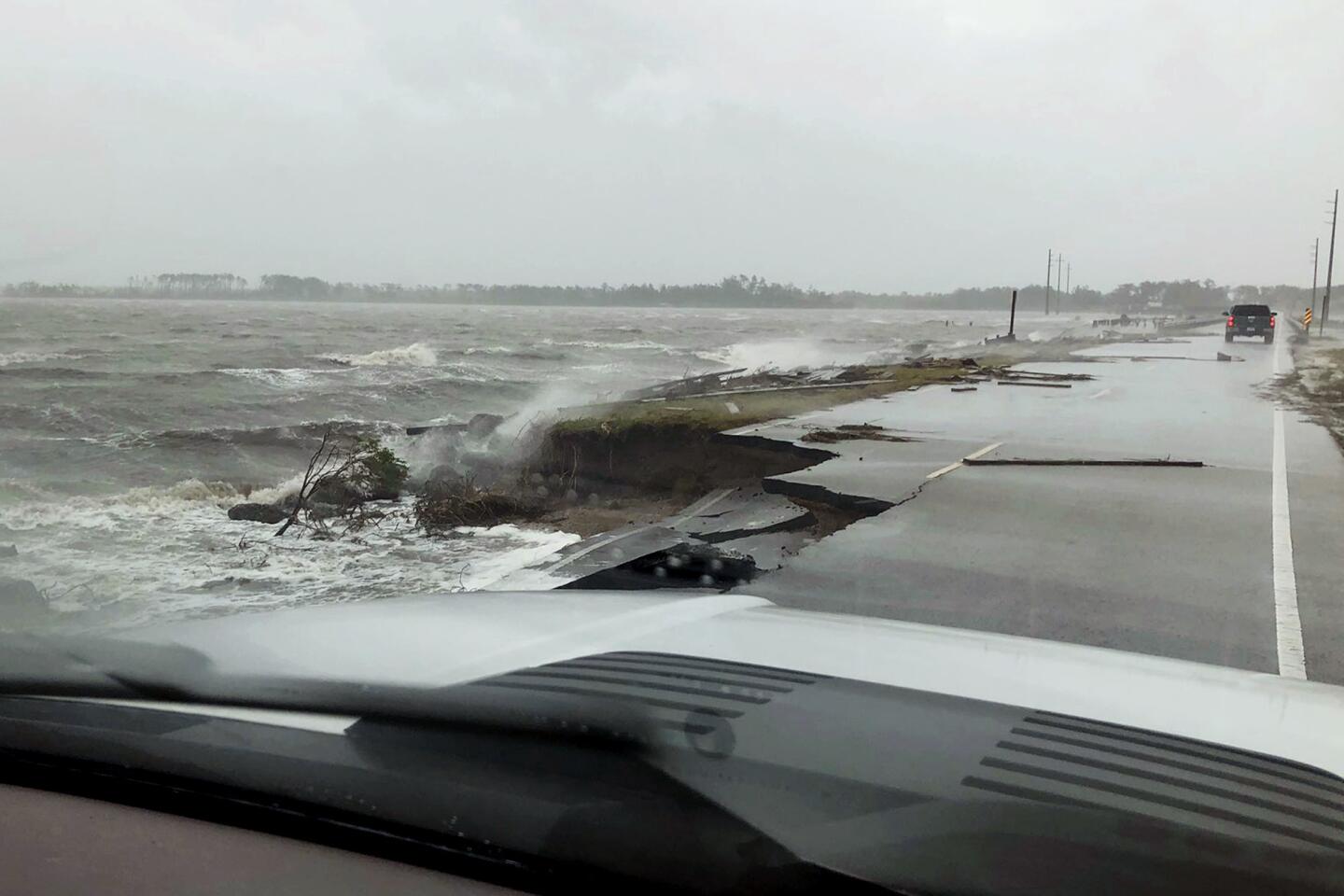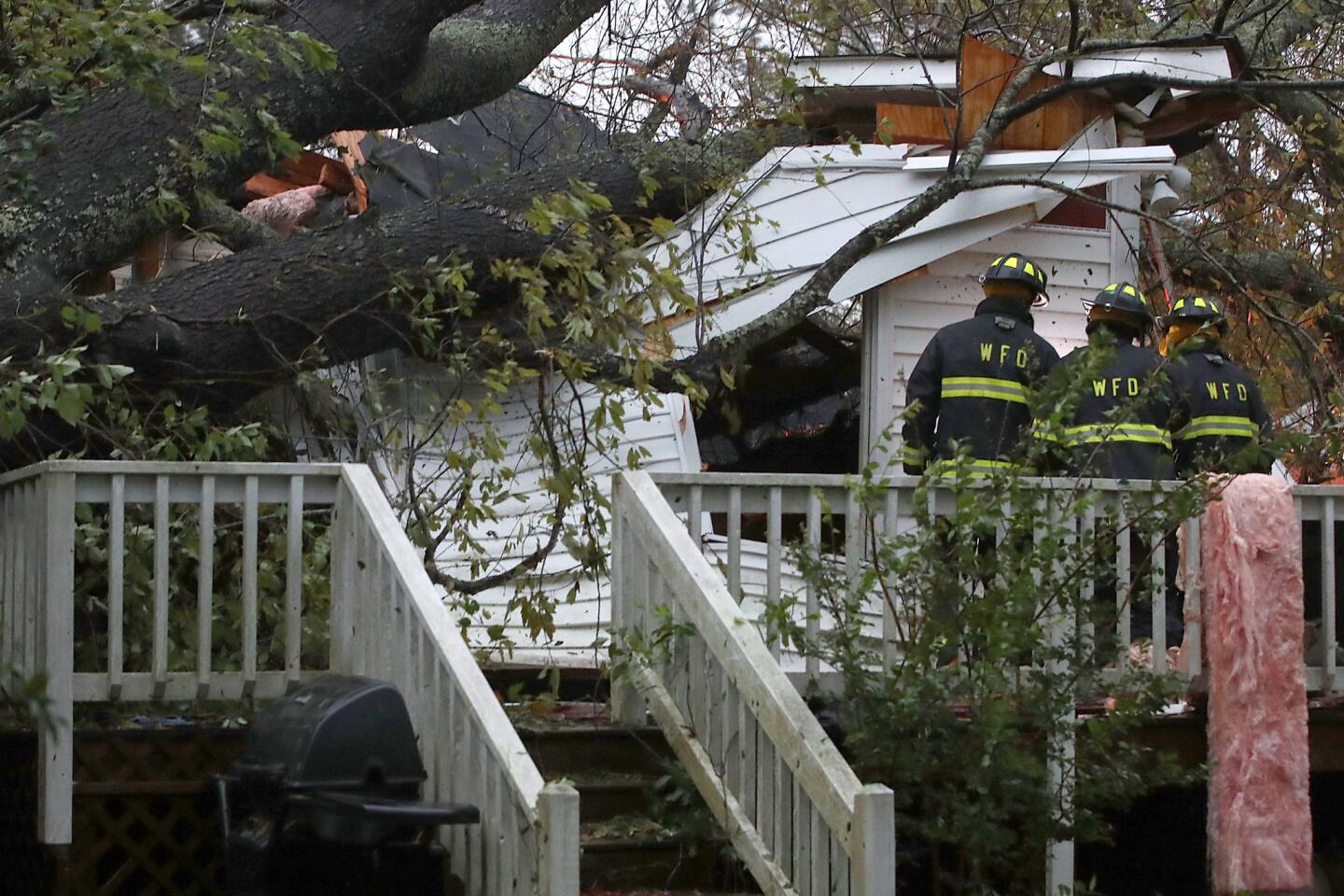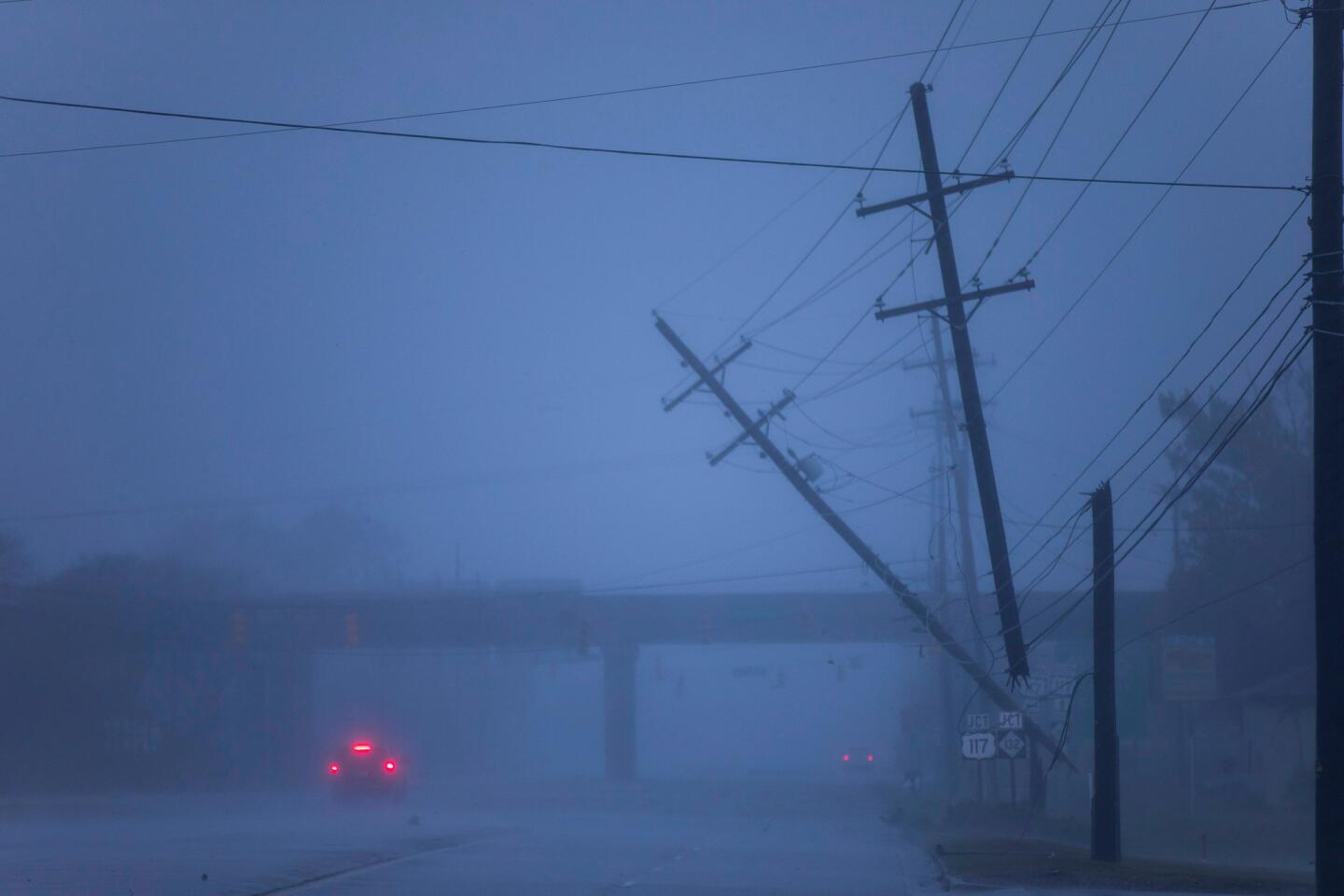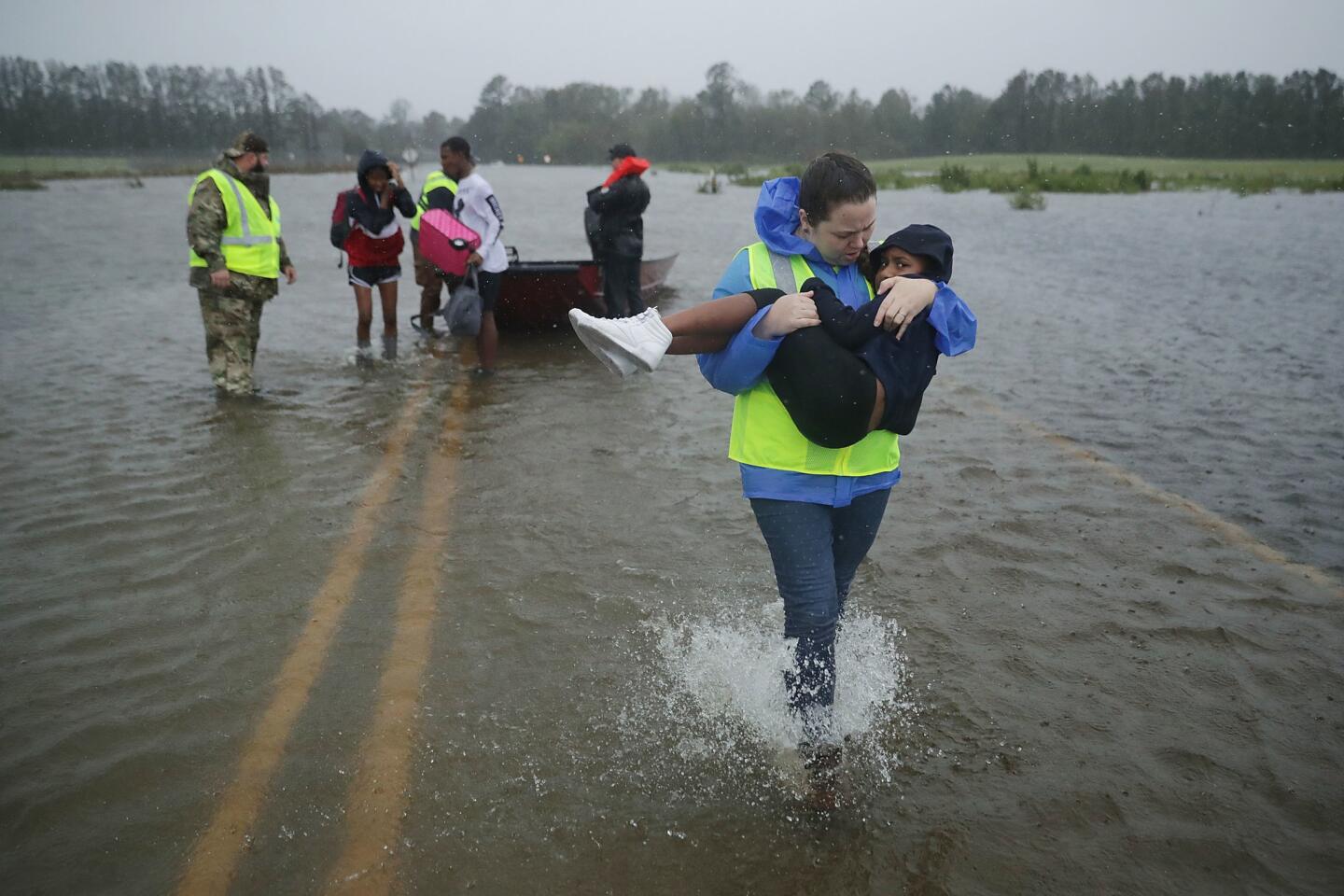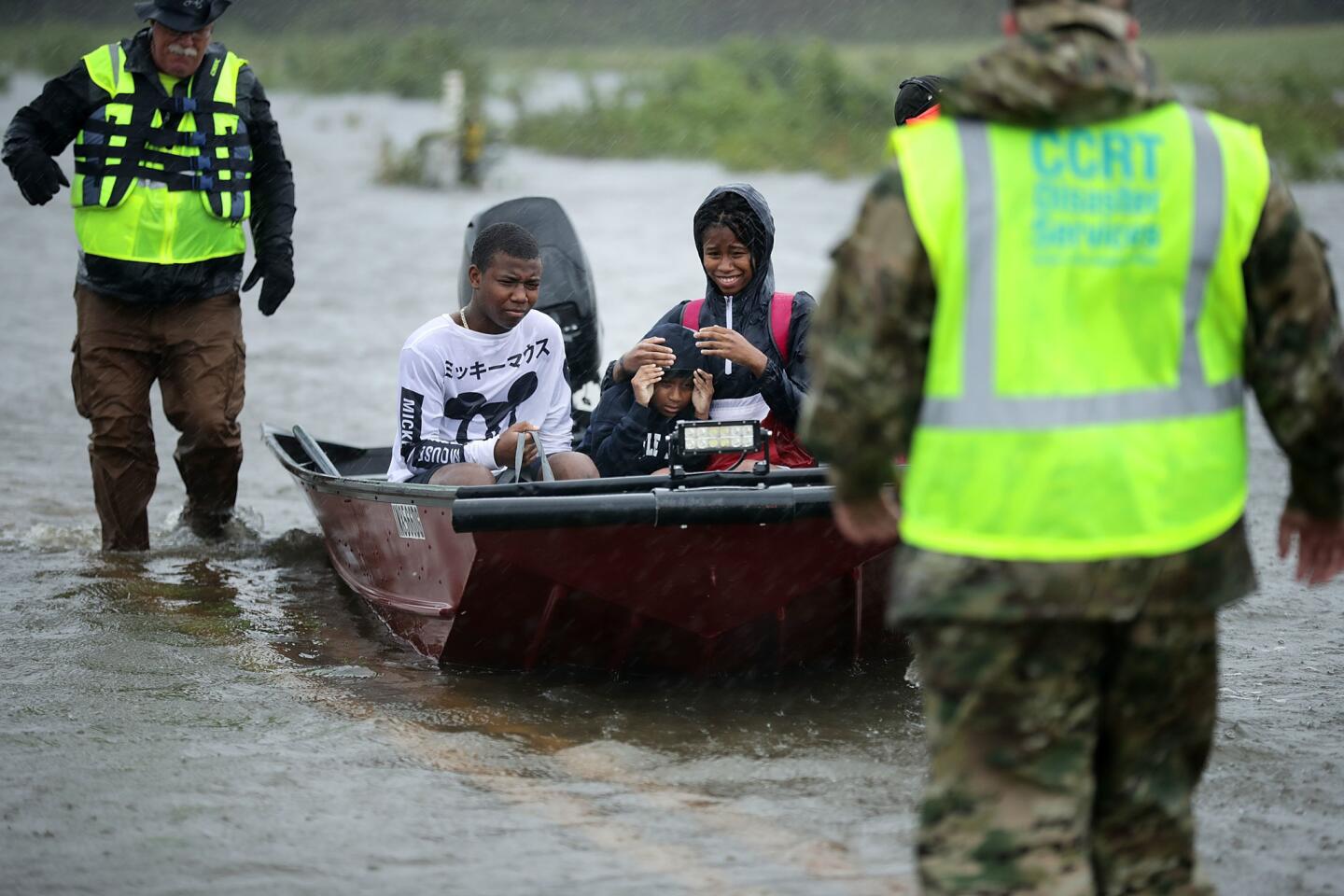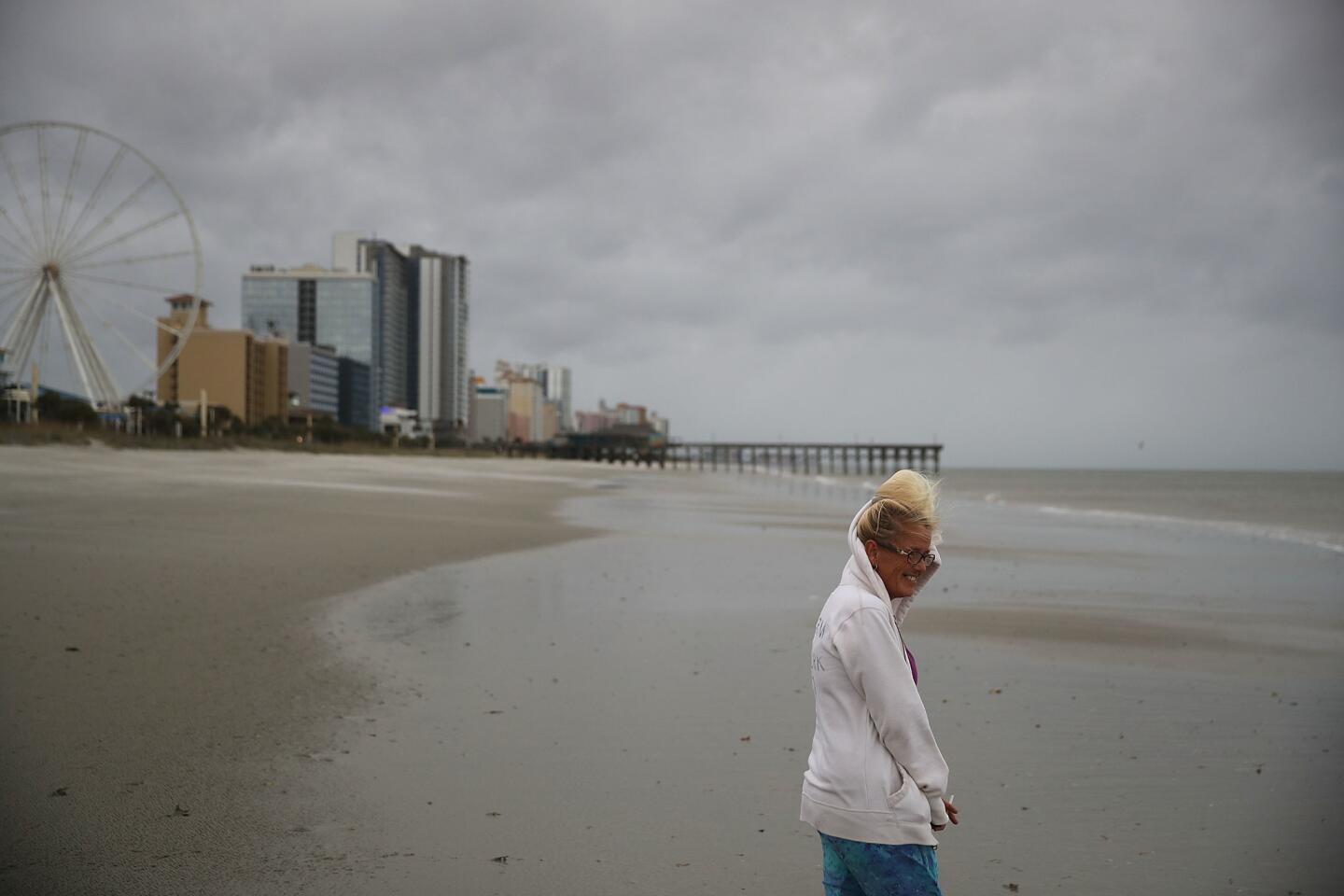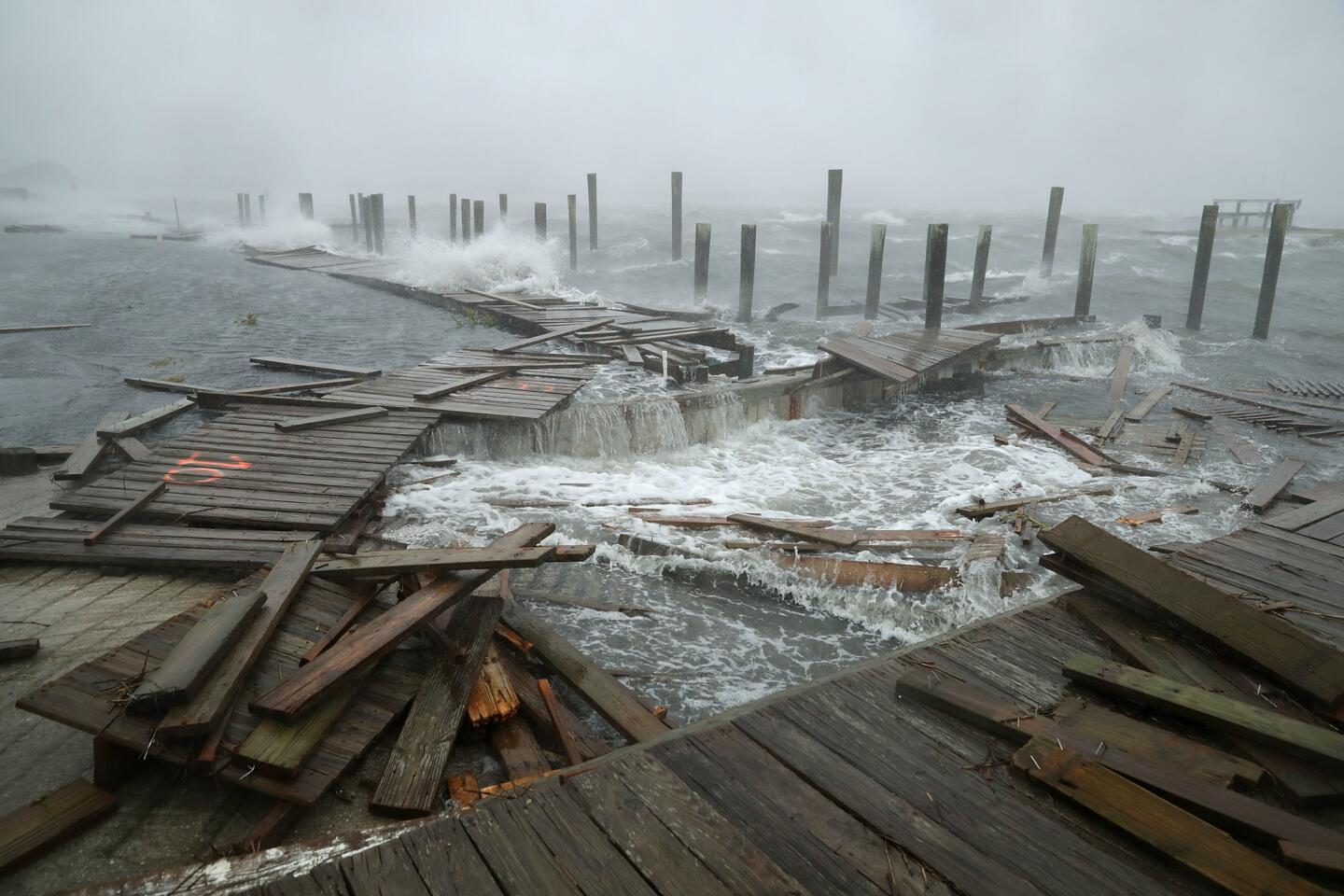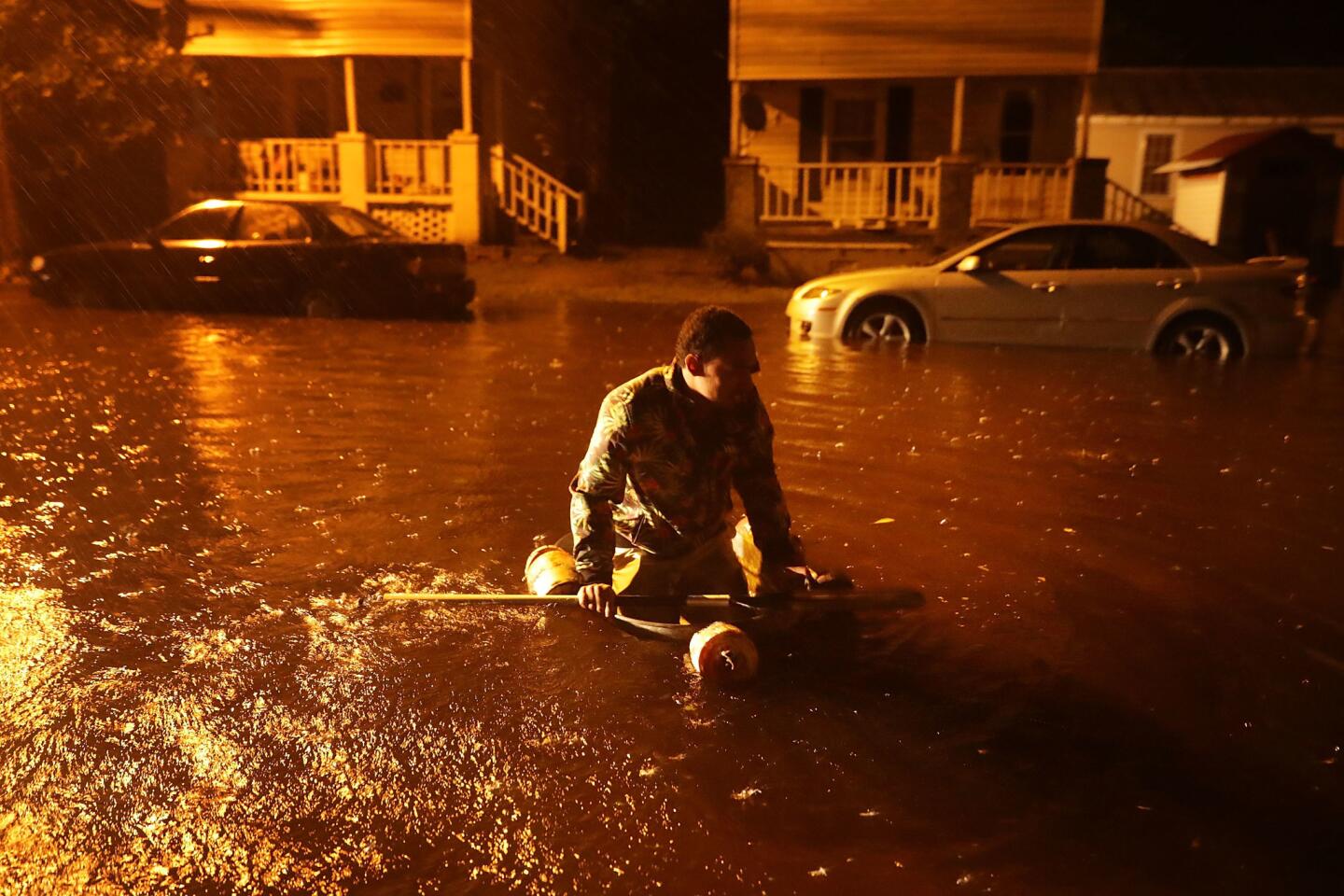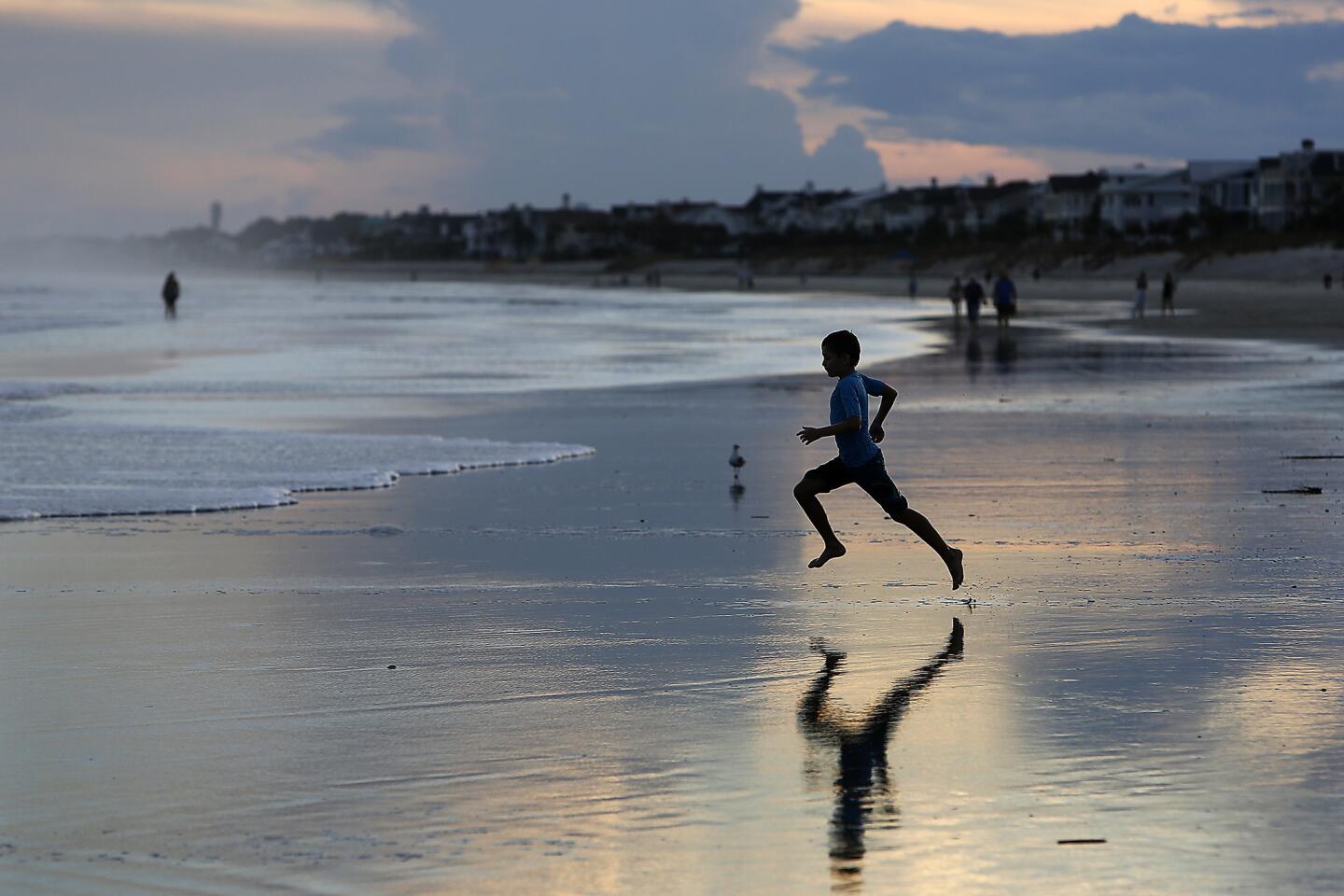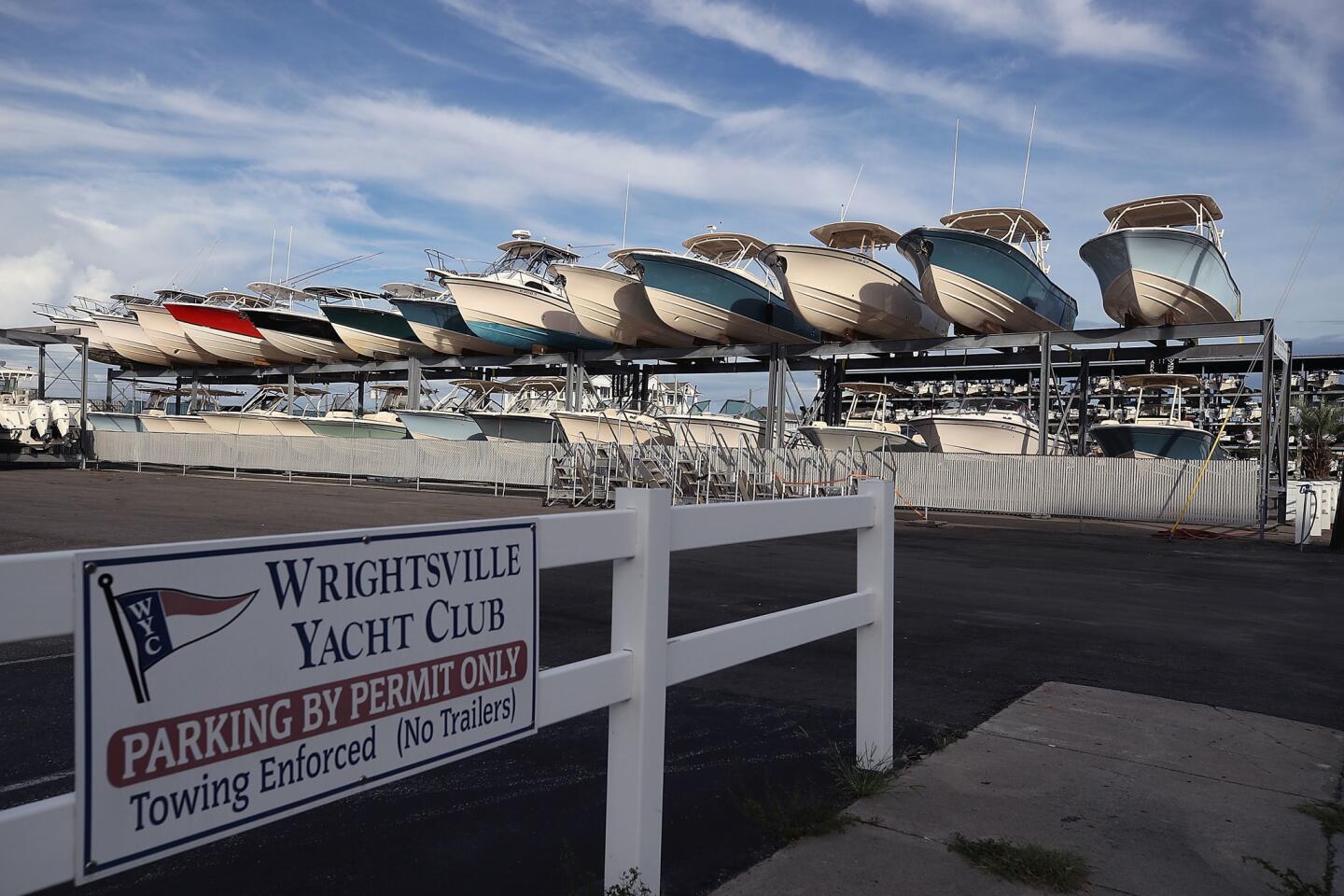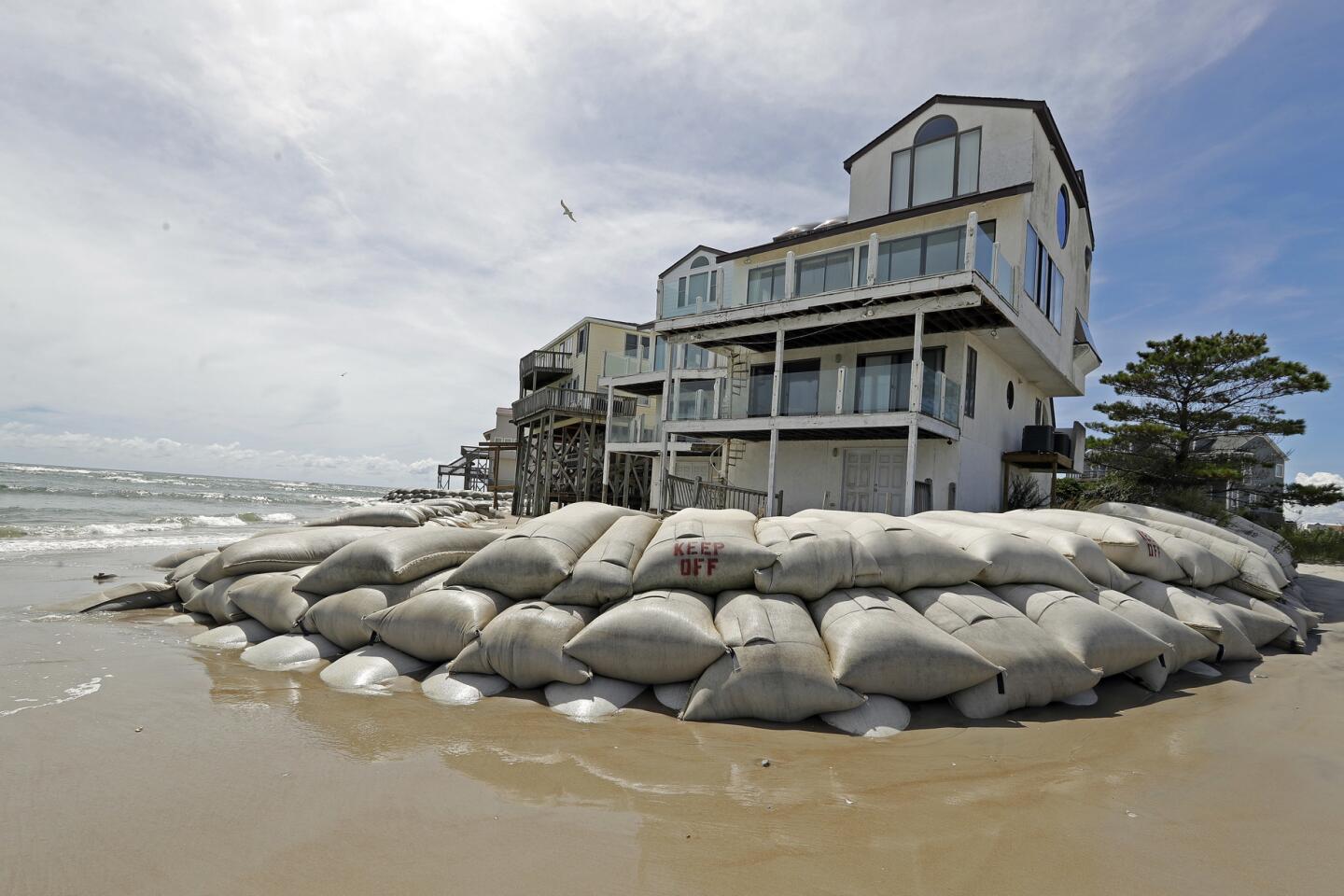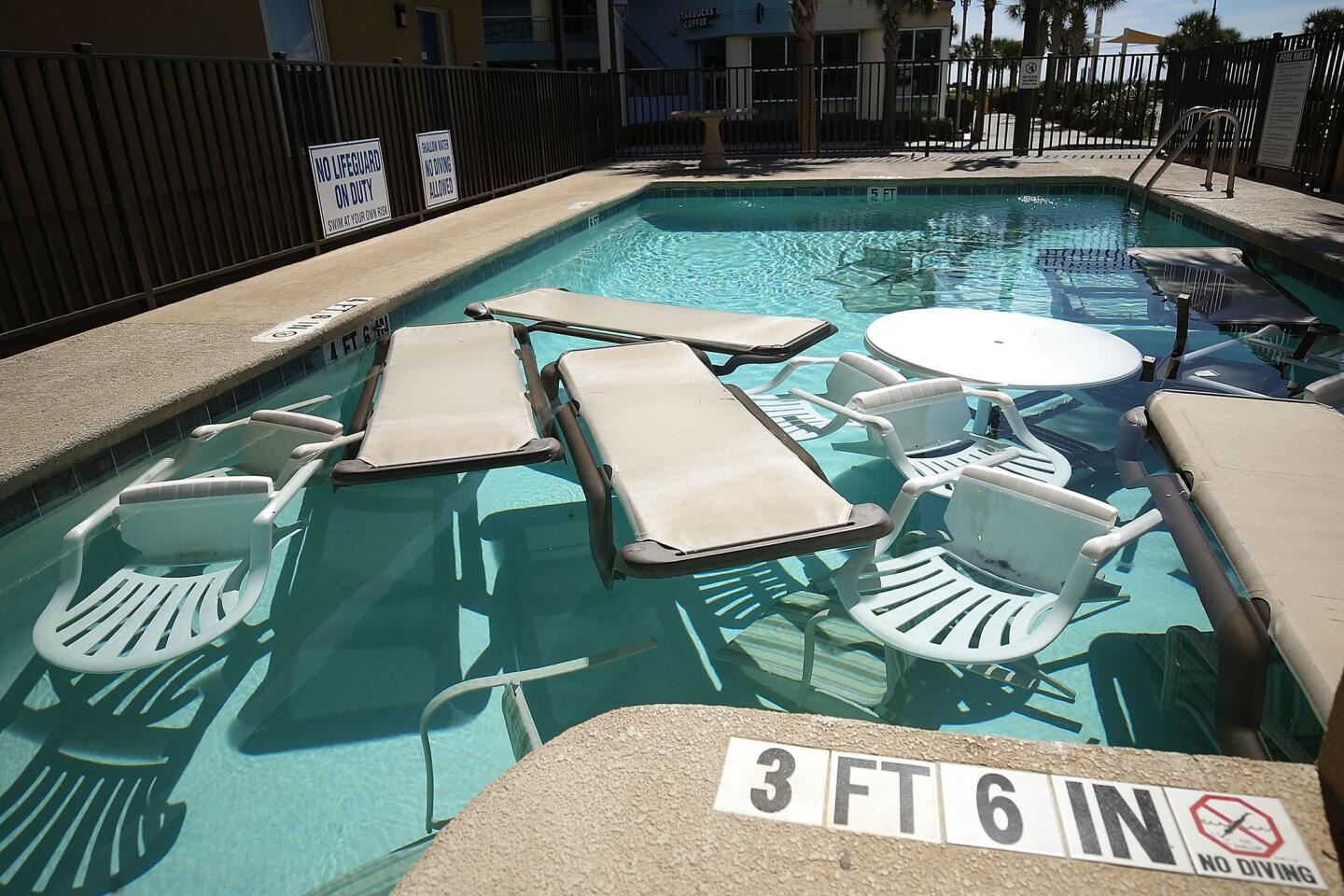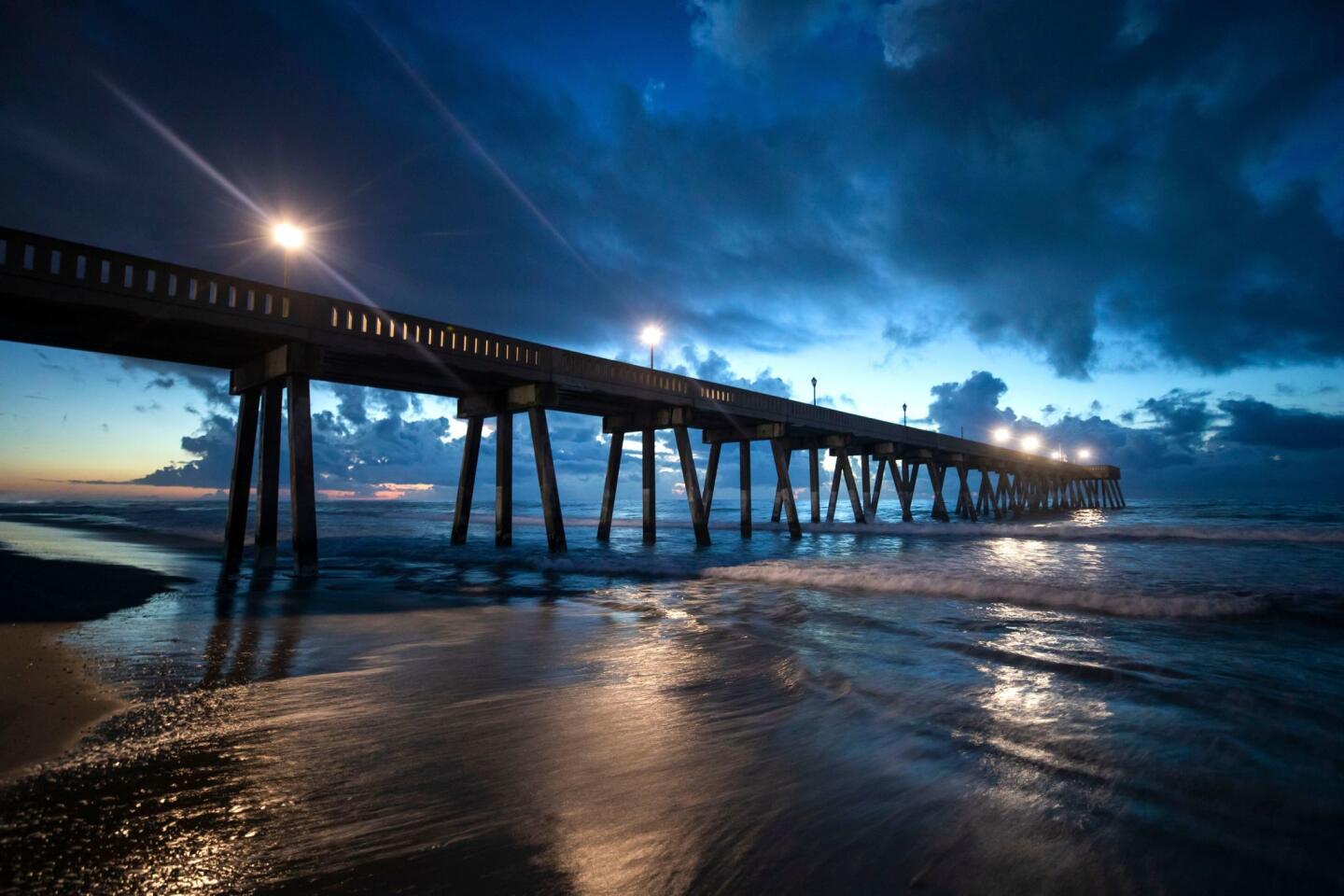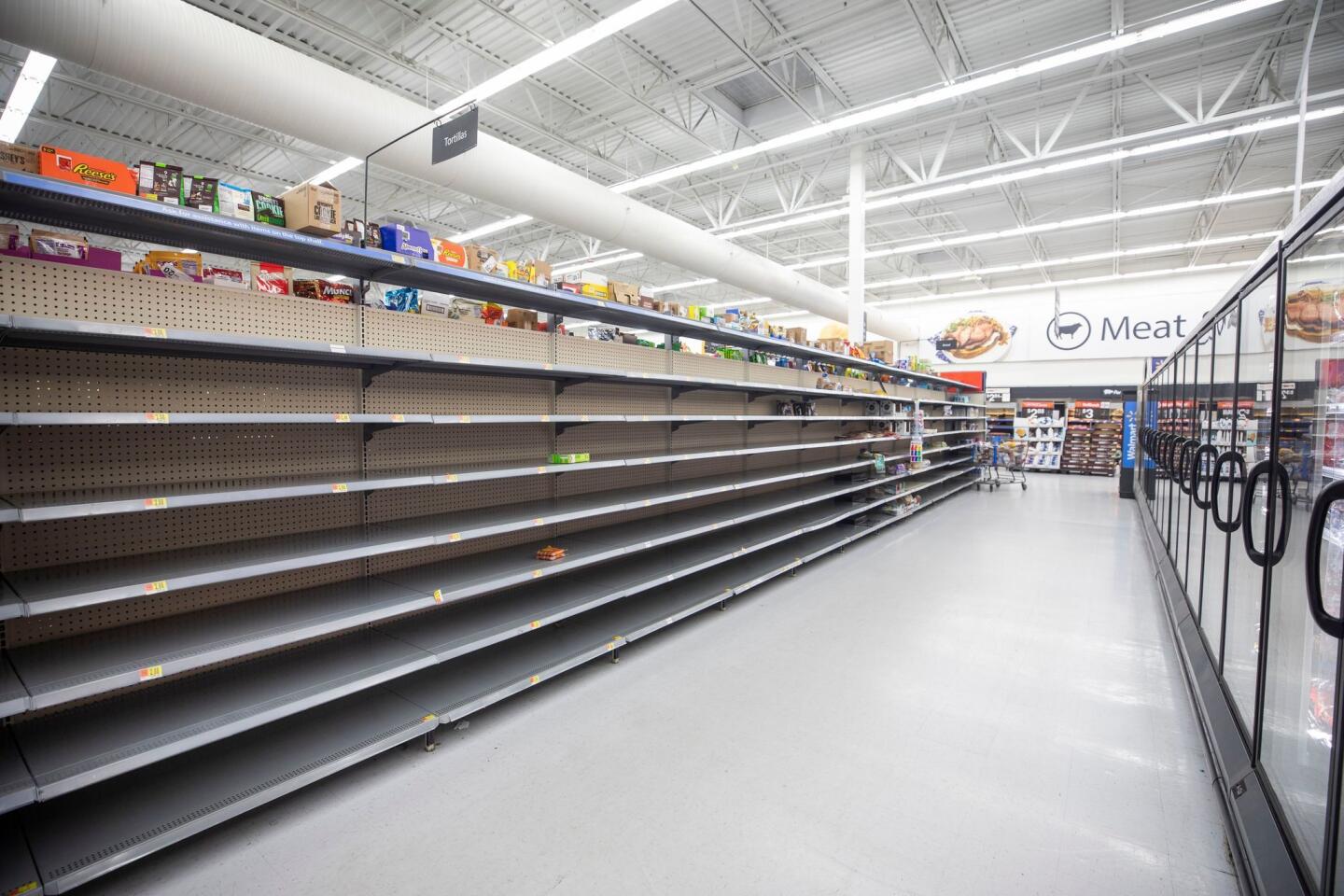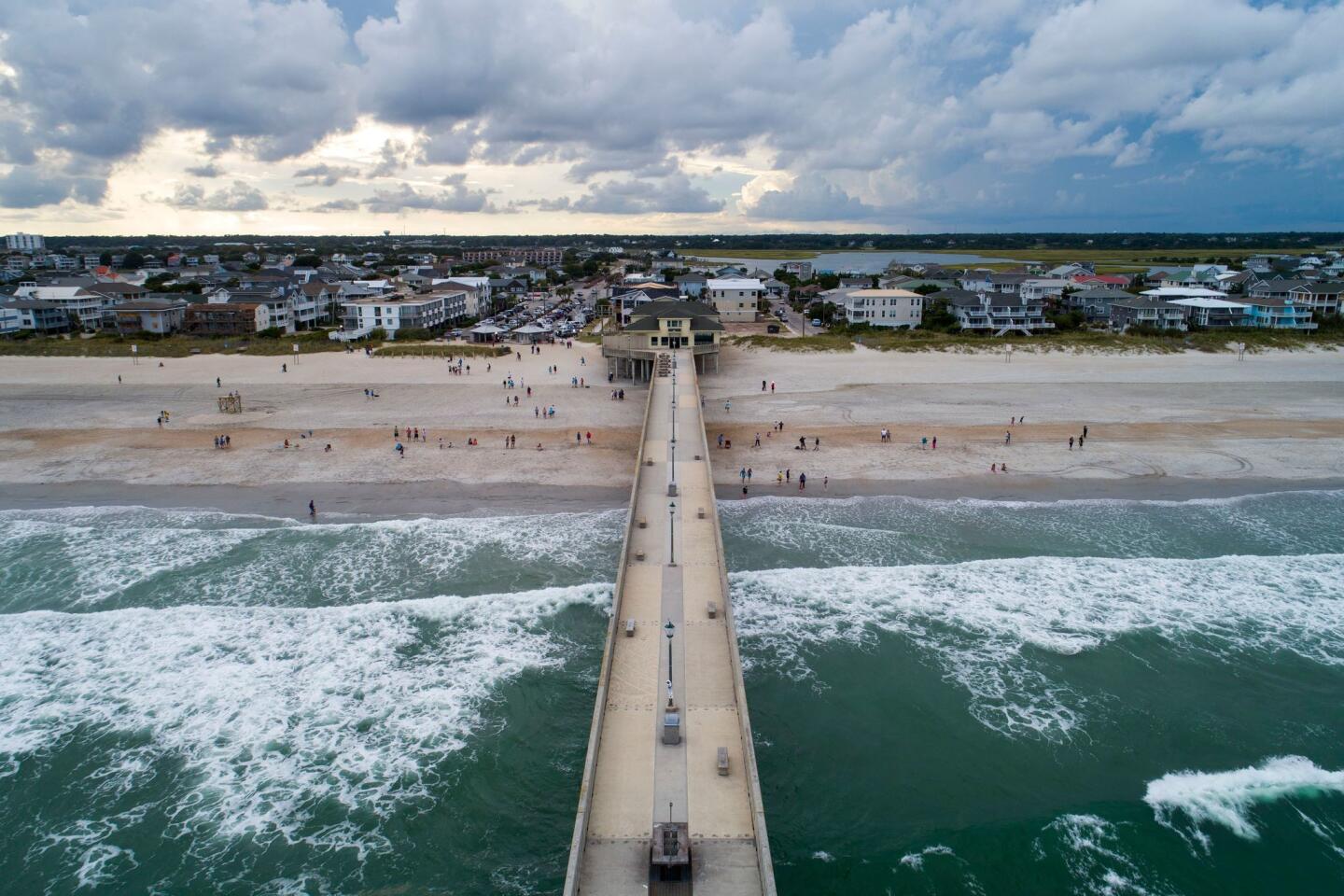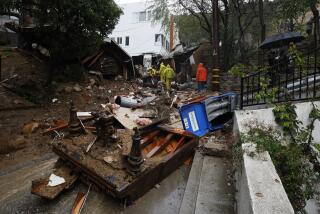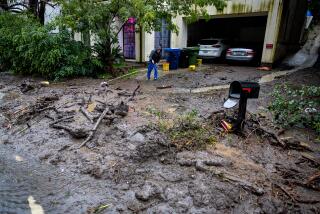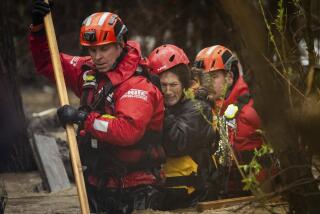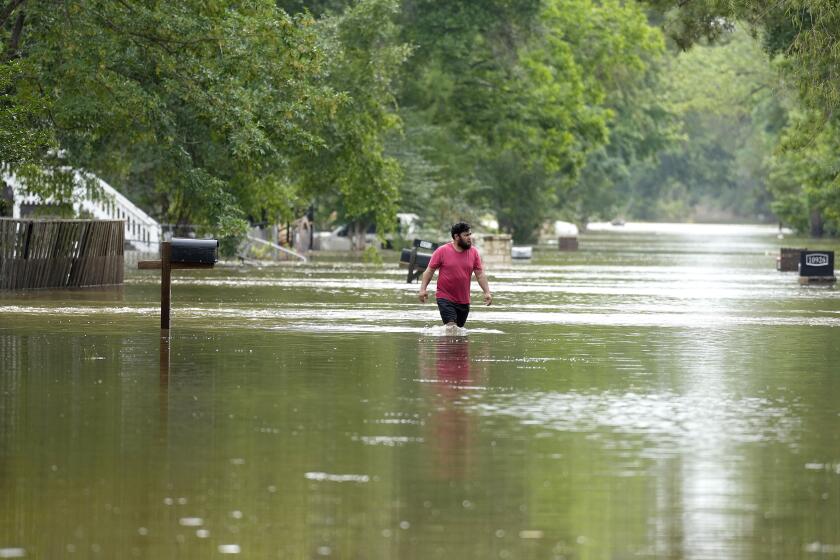Reporting from Conway, S.C. — With a plodding pace belying still-unspent fury, an increasingly deadly Tropical Storm Florence pushed deeper into the Carolinas on Saturday, inundating homes, toppling trees and pushing rivers far beyond their banks as rescuers in boats and helicopters rushed to keep pace.
Six new fatalities were reported Saturday, bringing the storm toll to 11. Nearly a million people, mainly in North Carolina, were without power a day after Florence made landfall a few miles northeast of Wilmington, N.C., as a howling Category 1 hurricane.
By midafternoon Saturday, the massive storm was crawling westward at about 3 mph, unleashing havoc as it went. Inland, the peril grew; on the coast, storm surge warnings were discontinued Saturday.
As the winds abated, the waters rose. And rose.
Mayor Dana Outlaw of hard-hit New Bern, N.C., said Florence’s lumbering pace, with lingering, rain-dumping storm bands hovering overhead, increased the damage and danger.
“This one stayed around awhile,” he said.
Floodwaters surged over roads, prompting the closing of Interstate 95 just north of the Carolinas’ border. With more than 2 feet of rain having already fallen in coastal areas and more forecast for days to come in the western mountains, officials ordered new evacuations affecting thousands.
Those included a mandatory evacuation issuedbecause of “imminent danger” for anyone who lives within a mile of the banks of North Carolina’s Cape Fear River and Little River. That took in parts of the city of Fayetteville, population 200,000.
1/61
A road is washed out by the rains from Hurricane Florence as it passed through the area in Fayetteville, N.C.
(Joe Raedle / Getty Images) 2/61
Flood waters from Hurricane Florence surround a house and flow along the street in Fayetteville, N.C.
(Joe Raedle / Getty Images) 3/61
A man moves his horses from rising water in Lumberton, N.C., following flooding from now Tropical Depression Florence.
(Gerry Broome / Associated Press) 4/61
Helen McKoy walks down a flooded street in her neighborhood as Florence continues to dump heavy rain in Fayetteville, N.C.
(David Goldman / Associated Press) 5/61
Homes along the New River are flooded as a result of high tides and rain from Hurricane Florence, which moved through the area in Jacksonville, N.C.
(Steve Helber / Associated Press) 6/61
Members of the North Carolina Task Force urban search and rescue team wade through a flooded neighborhood looking for residents who stayed behind as Florence continues to dump heavy rain in Fayetteville, N.C.
(David Goldman / Associated Press) 7/61
Floodwaters from Hurricane Florence rush down Cool Spring Street, inundating the St. James Church in Fayetteville, N.C.
(Jim Lo Scalzo / EPA / Shutterstock) 8/61
Erick Martinez grills chicken on the porch of his home as floodwaters from Hurricane Florence rise in the Magnolia Mobile Home Park north of Lumberton, N.C.
(Jim Lo Scalzo / EPA / Shutterstock) 9/61
A resident walks from his flooded house toward the crew of the Cajun Navy in Lumberton, N.C.
(Alex Edelman / AFP/Getty Images) 10/61
A boat pushed ashore by Hurricane Florence rests in front of a damaged home in New Bern, N.C.
(Gray Whitley / Associated Press) 11/61
Floodwaters surround buildings on Front Street in downtown Swansboro N.C.
(Tom Copeland / Associated Press) 12/61
A sign asks for prayer Friday in Lumberton, N.C., as Florence bears down
(David Goldman / Associated Press) 13/61
High winds toppled a scoreboard, knocked down a wall and uprooted trees, crushing a car, at a baseball field in New Bern, N.C.
(Chip Somodevilla / Getty Images) 14/61
A section of an exit ramp on Highway 17 was washed away when Florence hit new Bern, N.C., as a Category 1 hurricane.
(Chip Somodevilla / Getty Images) 15/61
A man makes a phone call from the front porch of his home surrounded by floodwaters in Jacksonville, N.C.
(Chuck Burton / Associated Press) 16/61
A store awning partially ripped away by high winds in Myrtle Beach, S.C.
(Alex Edelman / AFP/Getty Images) 17/61
A mother and her infant were killed Friday when a massive tree fell on their house in Wilmington, N.C. They were the first reported fatalities from Hurricane Florence.
(Andrew Caballero-Reynolds / AFP/Getty Images) 18/61
Volunteers help rescue residents and their pets from flooded homes Friday in New Bern, N.C.
(Chip Somodevilla / Getty Images) 19/61
Homes are flooded after a surge from Hurricane Florence flooded the Neuse River in New Bern, N.C.
(Chip Somodevilla / Getty Images) 20/61
The Trent River (background) overflows its banks and floods a neighborhood during Hurricane Florence in River Bend, N.C.
(Chip Somodevilla / Getty Images) 21/61
People walk through the high winds from Hurricane Florence in downtown Swansboro N.C.
(Tom Copeland / Associated Press) 22/61
Mike Kiernan takes photos of the damage to his home in Wilmington, N.C.
(Chuck Burton / Associated Press) 23/61
A woman holds a baby as she watches rising flood waters on the Cape Fear River during Hurricane Florence in Wilmington, N.C.
(ANDREW CABALLERO-REYNOLDS / AFP / Getty Images) 24/61
Members of the FEMA Urban Search and Rescue Task Force 4 from Oakland search a flooded neighborhood for evacuees in Fairfield Harbour, N.C.
(Chip Somodevilla / Getty Images) 25/61
Sam Parks walks through flooded Water Street as Hurricane Florence comes ashore in Wilmington, N.C.
(Jim Lo Scalzo / EPA/Shutterstock) 26/61
Residents drive through flooded Water Street as Hurricane Florence comes ashore in Wilmington, N.C.
(Jim Lo Scalzo / EPA/Shutterstock) 27/61
Wind and water from Hurricane Florence damages the highway leading off Harkers Island, N.C.
(Jordan Guthrie / Associated Press) 28/61
Residents look at downed trees as Hurricane Florence passes over Wilmington, N.C.
(Andrew Caballero-Reynolds / AFP/Getty Images) 29/61
Firefighters arrive at a home where a large tree fell and trapped three people in Wilmington, N.C. One man was taken out of the home in critical condition, and the condition of the others is unknown.
(Mark Wilson / Getty Images) 30/61
A boat is wedged in trees during Hurricane Florence in Oriental, N.C.
(Angie Propst / Associated Press) 31/61
Rescue workers rush a man to an ambulance after a giant tree toppled onto his house, killing two other people when Hurricane Florence came ashore in Wilmington, N.C.
(Jim Lo Scalzo / EPA/Shutterstock) 32/61
Waves slam the Oceanana Pier & Pier House Restaurant in Atlantic Beach, N.C.
(Travis Long / Associated Press) 33/61
Electric poles that snapped in half sway from their wires as Hurricane Florence comes ashore in Wilmington, N.C.
(Jim Lo Scalzo / EPA/Shutterstock) 34/61
A sign warns people away from Union Point Park after it was flooded by the Neuse River in New Bern, N.C.
(Chip Somodevilla / Getty Images) 35/61
The awning of a Shell gas station was torn off when Hurricane Florence came ashore in Wilmington, N.C.
(Jim Lo Scalzo / EPA/Shutterstock) 36/61
Volunteers from the Civilian Crisis Response Team help rescue three children from their flooded home in James City, N.C.
(Chip Somodevilla / Getty Images) 37/61
Volunteers from the Civilian Crisis Response Team help rescue three children from their flooded home in James City, N.C.
(Chip Somodevilla / Getty Images) 38/61
Linda Deem walks along the beach as winds from Hurricane Florence are felt in Myrtle Beach, S.C
(Joe Raedle / Getty Images) 39/61
Linda Stephens checks out the weather as the force of Hurricane Florence is beginning to be felt in Myrtle Beach, S.C.
(Joe Raedle / Getty Images) 40/61
Portions of a boat dock and boardwalk are destroyed by powerful wind and waves as Hurricane Florence arrives in Atlantic Beach. Coastal cities in North Carolina, South Carolina and Virginia are under evacuation orders.
(Chip Somodevilla / Getty Images) 41/61
Michael Nelson floats in a boat made from a metal tub and fishing floats after the Neuse River went over its banks and flooded his street during Hurricane Florence in New Bern, N.C.
(Chip Somodevilla / Getty Images) 42/61
A child sits on a mattress at a Hurricane Florence evacuation shelter at Conway High School in Conway, S.C.
(Alex Edelman / AFP/Getty Images) 43/61
Alejandra Rubio comforts her daughter Sarahi Ramos on Thursday in their hotel room in Wilmington, N.C., where they will wait out Hurricane Florence.
(Robert Gourley / For The Times ) 44/61
The Ramos family prepares dinner and watches the weather forecast in their hotel room Thursday night in Wilmington, N.C., where they will wait out Hurricane Florence.
(Robert Gourley/ For The Times ) 45/61
Vickie Grate, left, waits in a shelter with her son Chris, center, and his girlfriend, Sarah, after evacuating from their homes in Conway, S.C., on Wednesday.
(David Goldman / Associated Press) 46/61
Doug Lewis, left, and Chris Williams cover the windows of Knuckleheads Bar and Grill in Myrtle Beach, S.C.
(Joe Raedle / Getty Images) 47/61
A statue of Poseidon stands along the boardwalk in Morehead City, N.C., on Wednesday. Many coastal areas in Virginia and the Carolinas are under evacuation orders.
(Chip Somodevilla / Getty Images) 48/61
Sunset on the Isle of Palms, S.C., on Wednesday. Hurricane Florence has weakened slightly, but is still expected to cause potentially life-threatening storm surge and flooding.
(Mic Smith / Associated Press) 49/61
Boats are dry-docked at the Wrightsville Yacht Club on Wednesday in Wrightsville Beach, N.C.
(Mark Wilson / Getty Images) 50/61
The Lager Heads Tavern is secured on Tuesday as locals prepare for the arrival of Hurricane Florence in Wrightsville Beach, N.C.
(Mark Wilson / Getty Images) 51/61
Willy Cortright, foreground, and Erik Barfield, on roof, cover the windows of a home with plywood panels in Beaufort, N.C. Both said they planned to ride out the storm on the coast.
(Robert Gourley / For The Times) 52/61
Sandbags surround homes on North Topsail Beach, N.C.
(Chuck Burton / Associated Press) 53/61
Poolside furniture is placed in the pool of a hotel before the storm arrived in Myrtle Beach, S.C.
(Mark Wilson / Getty Images) 54/61
A mandatory evacuation is in effect in Topsail Beach, N.C.
(Mark Wilson / Getty Images) 55/61
Daniel Vaughn, left, and Frank Murphy fill sandbags while preparing for Florence in Wrightsville Beach, N.C.
(Mark Wilson / Getty Images) 56/61
Sunrise in Wrightsville Beach, N.C., two days ahead of the predicted landfall of Hurricane Florence.
(Jim Lo Scalzo / EPA/Shutterstock) 57/61
The bread aisle at Walmart is empty two days before Hurricane Florence is expected to strike Wilmington, N.C.
(Jim Lo Scalzo / EPA/Shutterstock) 58/61
Johnny Mercer’s Fishing Pier juts into the Atlantic Ocean two days before Hurricane Florence is expected to strike Wrightsville Beach, N.C.
(Jim Lo Scalzo / EPA/Shutterstock) 59/61
Chuck Ledford, left, watches “Looney Tunes” with his daughter, Misty, as they evacuate ahead of Hurricane Florence in Wilmington, N.C.
(Caitlin Penna / EPA/Shutterstock) 60/61
Jacob Whitehead, left, and Matt Jones hit golf balls into the surf as Hurricane Florence approaches in Wrightsville Beach, N.C.
(Mark Wilson / Getty Images) 61/61
People evacuate ahead of Hurricane Florence as they seek shelter at Emma B. Trask Middle School in Wilmington, N.C.
(Caitlin Penna / EPA/Shutterstock) In all, an astonishing 18 trillion gallons of rain could fall on the Southeast and Mid-Atlantic states, according to the Associated Press. That’s as much water as there is in the Chesapeake Bay, and enough to cover the state of Texas with nearly 4 inches of water, the news agency said.
Authorities warned it would be hard to keep pace with where all the water might wind up, how fast the storm would move and where it would tack next. “It has been most unpredictable,” said South Carolina Gov. Henry McMaster.
North Carolina Gov. Roy Cooper warned people who fled their homes against going back too soon, citing perils including flash flooding and falling trees.
Follow our live coverage of Tropical Storm Florence »
“If you are safe, stay put.... Don’t go back until this storm passes,” he implored at a briefing Saturday. “This system is unloading epic amounts of rainfall.”
The triple punch of falling rain, rising rivers and storm surges was already triggering catastrophic floods in several locales.
More than 450 people were rescued in New Bern, a city of 30,000 at the confluence of the Neuse and Trent rivers. The Coast Guard brought in helicopters and inflatable boats to pluck people from rooftops, cars and inundated homes.
The White House said President Trump had issued a disaster declaration for North Carolina a day earlier, freeing up funds for housing and home repair. Embroiled in a bitter social media dispute over the death toll in Puerto Rico last year from Hurricane Maria, Trump praised first responders and said his administration was fully prepared for whatever unfolded.
While the Carolinas bore the brunt, neighboring states braced for an expected blow. Virginia Gov. Ralph Northam told residents in the southwestern part of the state to prepare for likely flooding and a risk of landslides early in the coming week.
In a few areas, though, the picture was not as dark as feared. In North Carolina’s Outer Banks — beloved by tourists but highly vulnerable to storms — officials began allowing homeowners and workers to go back to the fragile barrier islands.
In South Carolina, emergency managers were watching several northeastern rivers that flooded two years ago during Hurricane Matthew, destroying homes and government offices.
One of those was the Waccamaw River in South Carolina’s Horry County, which had reached 8.9 feet by Saturday; it floods at 11 feet.
Forecasters said the river’s crest was expected at 19.1 feet, beating the record 17.9 feet set during Hurricane Matthew. The county has a population of 325,000, with about 20,000 in the riverfront county seat of Conway.
Along Conway’s Waccamaw Drive, residents who have already been flooded out of their homes three times in as many years had hours to decide again Saturday afternoon: Stay or go? Brian Saunders opted to leave, although most of his furniture would have to stay.
“We can’t get it all out — it’s too late,” he said as a neighbor helped carry out a few antique chairs, family heirlooms.
In North Carolina, unrelenting rains were expected to swell the Cape Fear River to 62 feet next week, 3 feet higher than during Matthew in 2016. The river runs through Fayetteville — home to the Army’s Ft. Bragg — where officials opened emergency shelters and urged riverfront residents to evacuate.
Less than 500 feet from the Cape Fear River in Fayetteville, residents of an apartment complex dashed from their homes to their cars in the pouring rain, stuffing their passenger seats and trunks with boxes of clothing, blankets and baby photos as the parking lot pooled with puddles.
“I feel so nervous, I’m going to throw up,” said Ashley Pulver, a 27-year-old dental hygiene student who had lived in the complex only a month. In her bare living room, she stood in green rubber boots, looking down at a box of pink children’s clothing and a plush Minnie Mouse in a pink-and-white polka-dot dress.
Major flooding was also expected to the east in Kinston on the Neuse River, expected to reach 27 feet by Monday, nearing the record 28.3 feet set during Hurricane Matthew. To the north, officials were monitoring the Tar River and sandbagging the French Broad River to the west and the Lumber River to the southeast.
“If you live in a floodplain and planned on staying, you might need to reevaluate,” said Joel Cline, a North Carolina native and meteorologist with the National Hurricane Center. “There’s a lot left to this even though the winds have died down and it’s inland.”
On the coast, Albemarle and Pamlico sounds will probably become bottlenecks, filling with runoff faster than they can drain into the ocean, he said.
“I don’t see any portion of the state of North or South Carolina that’s not going to be impacted in some way,” said Cline.
Even with the storm’s passing, it will be many days in some areas before life returns to anything approaching normal. In North Carolina’s New Hanover County, which includes Wilmington and the town of Wrightsville Beach, where the storm came ashore, nearly 90% of the county’s homes were still without power.
State and county officials hope to open food and water distribution centers for those who did not flee the storm. County Manager Chris Coudriet said authorities were preparing to open centers to provide food and water for up to 60,000 people a day for four days.
In addition to out-of-state emergency teams, volunteers from aid groups around the country have converged on North Carolina to help with the rescue efforts.
Ryan Bartholomew, who works with the Humanitarian Aid and Rescue Project, flew from Sacramento to Charlotte and then drove to flood-stricken New Bern to lend a hand.
“It gets to the point where they say, ‘We do need help,’” said Bartholomew, 32. “And we’re here to help.”
Hennessy-Fiske reported from Conway, S.C., Megerian from New Bern, N.C., and Jarvie from Fayetteville, N.C. Times staff writer Laura King contributed from Washington.
molly.hennessy-fiske@latimes.com
chris.megerian@latimes.com
jenny.jarvie@latimes.com
UPDATES:
4:30 p.m.: This article was updated with new details including information on evacuations in Fayetteville, N.C., lifting of coastal storm surge warnings, food and water distribution set in county where storm made landfall, some residents returning to Outer Banks, and warnings for Virginia in the coming week.
1:50 p.m.: This article was updated with details about rescues in New Bern and potential rainfall totals and comments from South Carolina Gov. Henry McMaster.
This article was originally published at 9:10 a.m.
